Environmental Issues and Taxes of New Zealand
VerifiedAdded on 2023/06/10
|26
|8799
|161
AI Summary
This research paper focuses on the major environmental issues and corresponding environmental taxes in New Zealand. It evaluates the beneficial influences of environmental taxation on society and the economy of New Zealand. The paper discusses the Wildlife Act, 1953, Environment Act 1986, Resource Management Act, 1991, Bio security Act, 1993, Conservation Act, 1987, and Ozone Layer Protection Act, 1996. The research questions include the predominant environmental issues in New Zealand, how to address issues related to taxes, benefits of environmental taxation, and the extent of governmental effort to maintain environmental balance in the country.
Contribute Materials
Your contribution can guide someone’s learning journey. Share your
documents today.
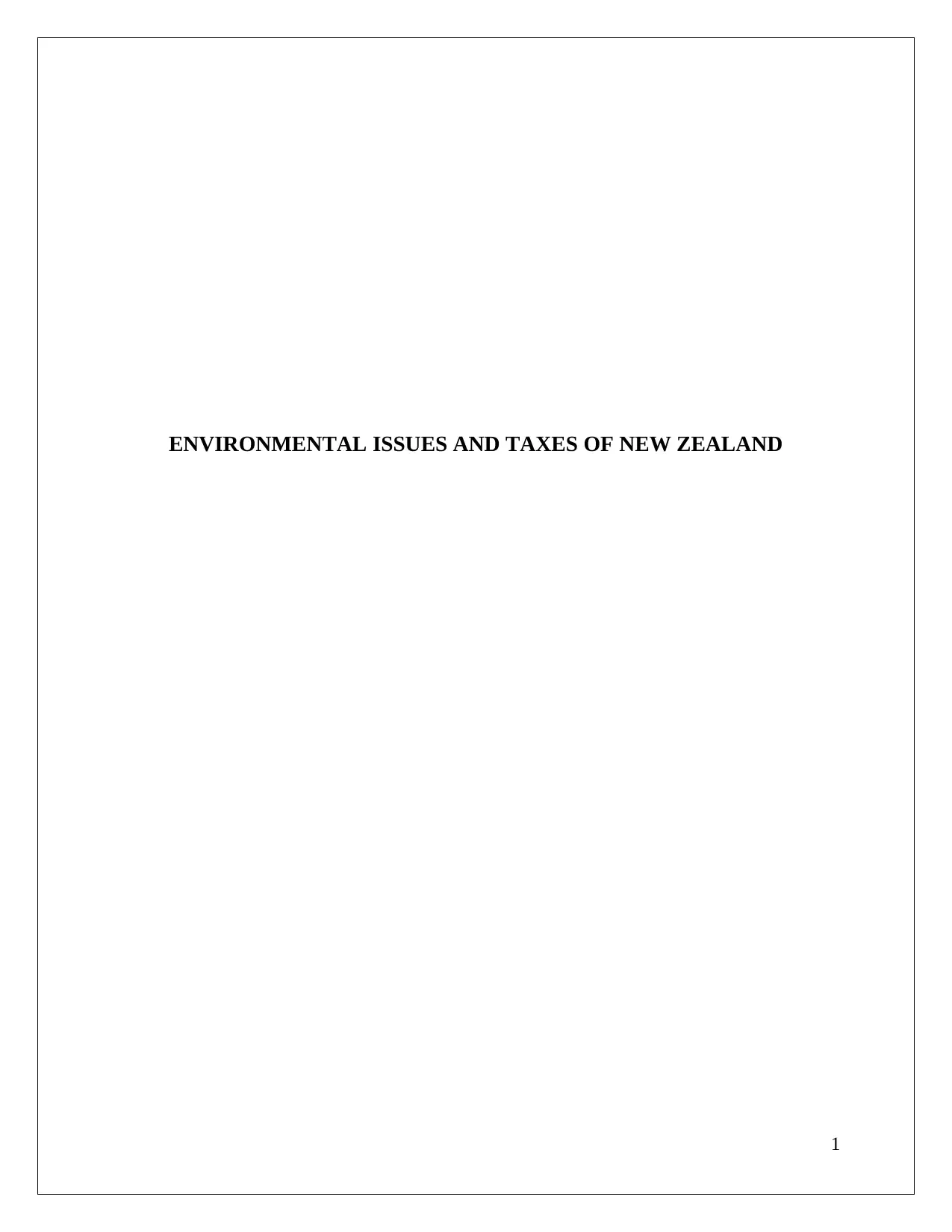
ENVIRONMENTAL ISSUES AND TAXES OF NEW ZEALAND
1
1
Secure Best Marks with AI Grader
Need help grading? Try our AI Grader for instant feedback on your assignments.
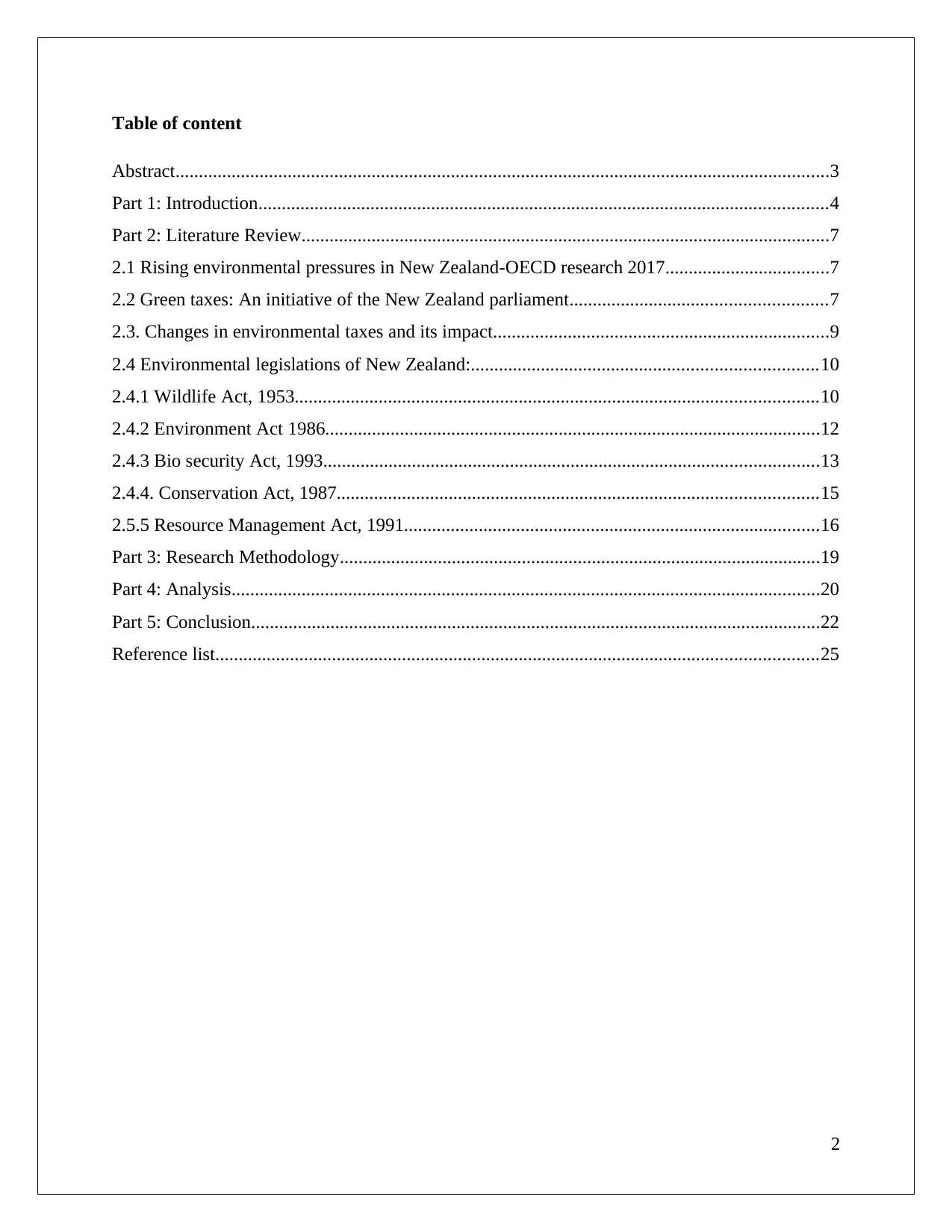
Table of content
Abstract............................................................................................................................................3
Part 1: Introduction..........................................................................................................................4
Part 2: Literature Review.................................................................................................................7
2.1 Rising environmental pressures in New Zealand-OECD research 2017...................................7
2.2 Green taxes: An initiative of the New Zealand parliament.......................................................7
2.3. Changes in environmental taxes and its impact........................................................................9
2.4 Environmental legislations of New Zealand:..........................................................................10
2.4.1 Wildlife Act, 1953................................................................................................................10
2.4.2 Environment Act 1986..........................................................................................................12
2.4.3 Bio security Act, 1993..........................................................................................................13
2.4.4. Conservation Act, 1987.......................................................................................................15
2.5.5 Resource Management Act, 1991.........................................................................................16
Part 3: Research Methodology.......................................................................................................19
Part 4: Analysis..............................................................................................................................20
Part 5: Conclusion..........................................................................................................................22
Reference list.................................................................................................................................25
2
Abstract............................................................................................................................................3
Part 1: Introduction..........................................................................................................................4
Part 2: Literature Review.................................................................................................................7
2.1 Rising environmental pressures in New Zealand-OECD research 2017...................................7
2.2 Green taxes: An initiative of the New Zealand parliament.......................................................7
2.3. Changes in environmental taxes and its impact........................................................................9
2.4 Environmental legislations of New Zealand:..........................................................................10
2.4.1 Wildlife Act, 1953................................................................................................................10
2.4.2 Environment Act 1986..........................................................................................................12
2.4.3 Bio security Act, 1993..........................................................................................................13
2.4.4. Conservation Act, 1987.......................................................................................................15
2.5.5 Resource Management Act, 1991.........................................................................................16
Part 3: Research Methodology.......................................................................................................19
Part 4: Analysis..............................................................................................................................20
Part 5: Conclusion..........................................................................................................................22
Reference list.................................................................................................................................25
2
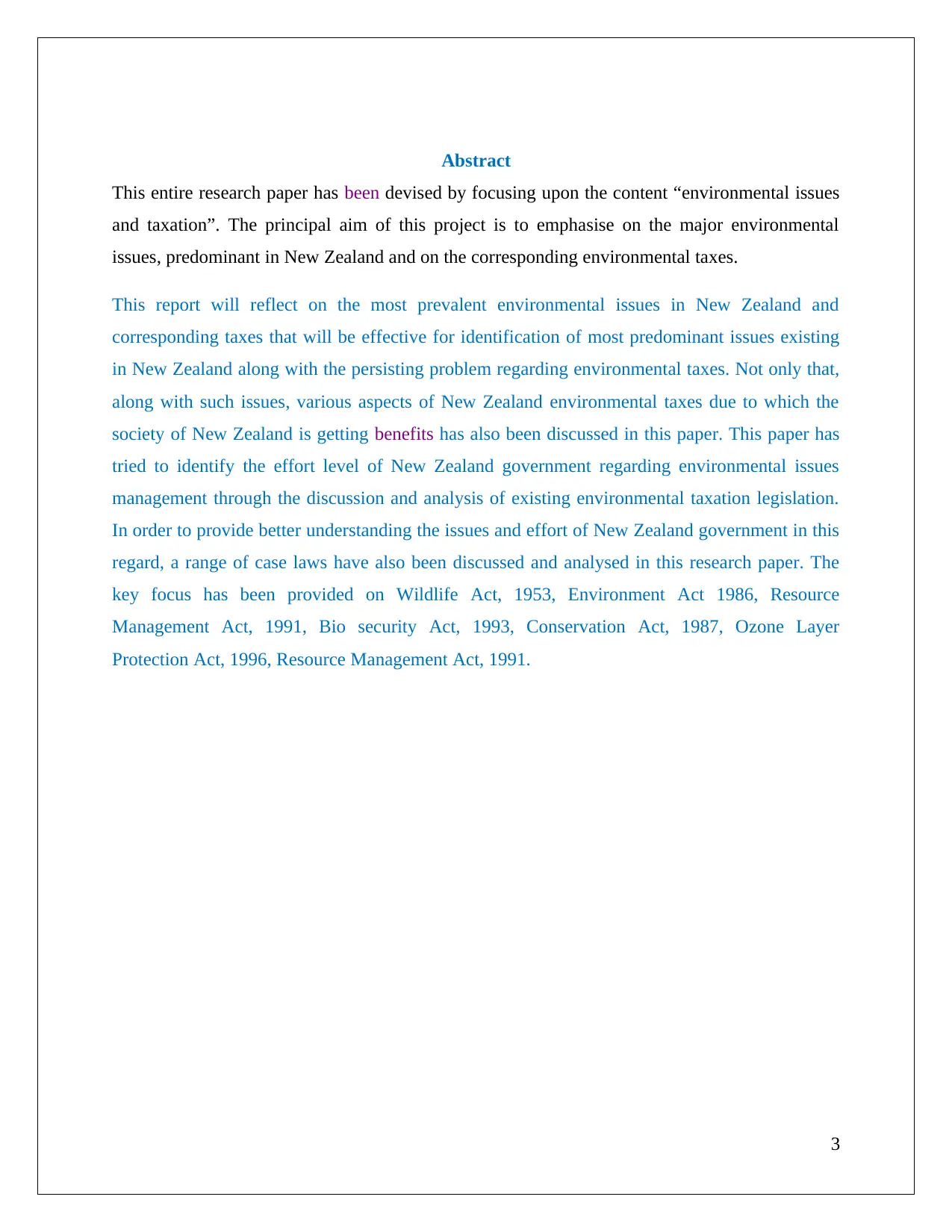
Abstract
This entire research paper has been devised by focusing upon the content “environmental issues
and taxation”. The principal aim of this project is to emphasise on the major environmental
issues, predominant in New Zealand and on the corresponding environmental taxes.
This report will reflect on the most prevalent environmental issues in New Zealand and
corresponding taxes that will be effective for identification of most predominant issues existing
in New Zealand along with the persisting problem regarding environmental taxes. Not only that,
along with such issues, various aspects of New Zealand environmental taxes due to which the
society of New Zealand is getting benefits has also been discussed in this paper. This paper has
tried to identify the effort level of New Zealand government regarding environmental issues
management through the discussion and analysis of existing environmental taxation legislation.
In order to provide better understanding the issues and effort of New Zealand government in this
regard, a range of case laws have also been discussed and analysed in this research paper. The
key focus has been provided on Wildlife Act, 1953, Environment Act 1986, Resource
Management Act, 1991, Bio security Act, 1993, Conservation Act, 1987, Ozone Layer
Protection Act, 1996, Resource Management Act, 1991.
3
This entire research paper has been devised by focusing upon the content “environmental issues
and taxation”. The principal aim of this project is to emphasise on the major environmental
issues, predominant in New Zealand and on the corresponding environmental taxes.
This report will reflect on the most prevalent environmental issues in New Zealand and
corresponding taxes that will be effective for identification of most predominant issues existing
in New Zealand along with the persisting problem regarding environmental taxes. Not only that,
along with such issues, various aspects of New Zealand environmental taxes due to which the
society of New Zealand is getting benefits has also been discussed in this paper. This paper has
tried to identify the effort level of New Zealand government regarding environmental issues
management through the discussion and analysis of existing environmental taxation legislation.
In order to provide better understanding the issues and effort of New Zealand government in this
regard, a range of case laws have also been discussed and analysed in this research paper. The
key focus has been provided on Wildlife Act, 1953, Environment Act 1986, Resource
Management Act, 1991, Bio security Act, 1993, Conservation Act, 1987, Ozone Layer
Protection Act, 1996, Resource Management Act, 1991.
3
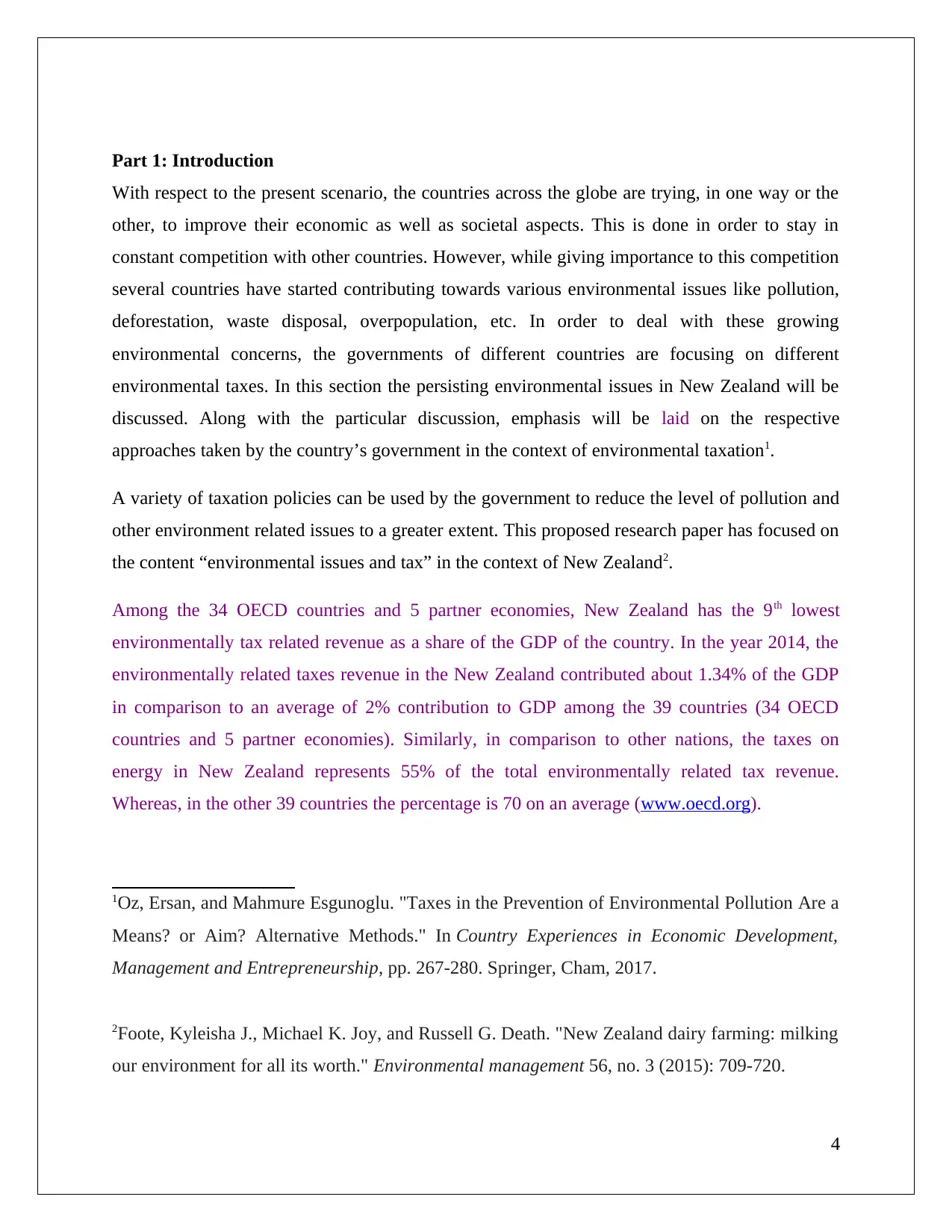
Part 1: Introduction
With respect to the present scenario, the countries across the globe are trying, in one way or the
other, to improve their economic as well as societal aspects. This is done in order to stay in
constant competition with other countries. However, while giving importance to this competition
several countries have started contributing towards various environmental issues like pollution,
deforestation, waste disposal, overpopulation, etc. In order to deal with these growing
environmental concerns, the governments of different countries are focusing on different
environmental taxes. In this section the persisting environmental issues in New Zealand will be
discussed. Along with the particular discussion, emphasis will be laid on the respective
approaches taken by the country’s government in the context of environmental taxation1.
A variety of taxation policies can be used by the government to reduce the level of pollution and
other environment related issues to a greater extent. This proposed research paper has focused on
the content “environmental issues and tax” in the context of New Zealand2.
Among the 34 OECD countries and 5 partner economies, New Zealand has the 9th lowest
environmentally tax related revenue as a share of the GDP of the country. In the year 2014, the
environmentally related taxes revenue in the New Zealand contributed about 1.34% of the GDP
in comparison to an average of 2% contribution to GDP among the 39 countries (34 OECD
countries and 5 partner economies). Similarly, in comparison to other nations, the taxes on
energy in New Zealand represents 55% of the total environmentally related tax revenue.
Whereas, in the other 39 countries the percentage is 70 on an average (www.oecd.org).
1Oz, Ersan, and Mahmure Esgunoglu. "Taxes in the Prevention of Environmental Pollution Are a
Means? or Aim? Alternative Methods." In Country Experiences in Economic Development,
Management and Entrepreneurship, pp. 267-280. Springer, Cham, 2017.
2Foote, Kyleisha J., Michael K. Joy, and Russell G. Death. "New Zealand dairy farming: milking
our environment for all its worth." Environmental management 56, no. 3 (2015): 709-720.
4
With respect to the present scenario, the countries across the globe are trying, in one way or the
other, to improve their economic as well as societal aspects. This is done in order to stay in
constant competition with other countries. However, while giving importance to this competition
several countries have started contributing towards various environmental issues like pollution,
deforestation, waste disposal, overpopulation, etc. In order to deal with these growing
environmental concerns, the governments of different countries are focusing on different
environmental taxes. In this section the persisting environmental issues in New Zealand will be
discussed. Along with the particular discussion, emphasis will be laid on the respective
approaches taken by the country’s government in the context of environmental taxation1.
A variety of taxation policies can be used by the government to reduce the level of pollution and
other environment related issues to a greater extent. This proposed research paper has focused on
the content “environmental issues and tax” in the context of New Zealand2.
Among the 34 OECD countries and 5 partner economies, New Zealand has the 9th lowest
environmentally tax related revenue as a share of the GDP of the country. In the year 2014, the
environmentally related taxes revenue in the New Zealand contributed about 1.34% of the GDP
in comparison to an average of 2% contribution to GDP among the 39 countries (34 OECD
countries and 5 partner economies). Similarly, in comparison to other nations, the taxes on
energy in New Zealand represents 55% of the total environmentally related tax revenue.
Whereas, in the other 39 countries the percentage is 70 on an average (www.oecd.org).
1Oz, Ersan, and Mahmure Esgunoglu. "Taxes in the Prevention of Environmental Pollution Are a
Means? or Aim? Alternative Methods." In Country Experiences in Economic Development,
Management and Entrepreneurship, pp. 267-280. Springer, Cham, 2017.
2Foote, Kyleisha J., Michael K. Joy, and Russell G. Death. "New Zealand dairy farming: milking
our environment for all its worth." Environmental management 56, no. 3 (2015): 709-720.
4
Secure Best Marks with AI Grader
Need help grading? Try our AI Grader for instant feedback on your assignments.
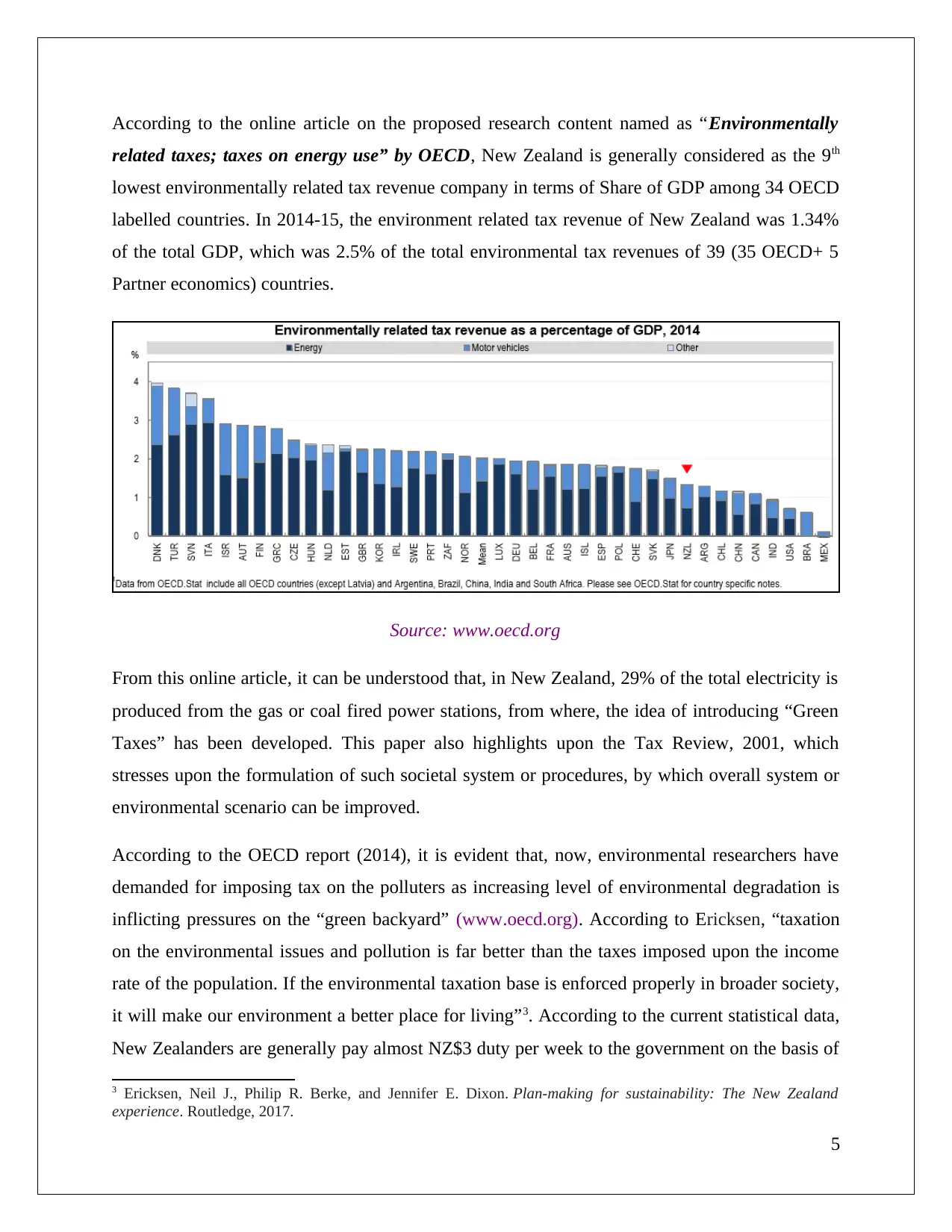
According to the online article on the proposed research content named as “Environmentally
related taxes; taxes on energy use” by OECD, New Zealand is generally considered as the 9th
lowest environmentally related tax revenue company in terms of Share of GDP among 34 OECD
labelled countries. In 2014-15, the environment related tax revenue of New Zealand was 1.34%
of the total GDP, which was 2.5% of the total environmental tax revenues of 39 (35 OECD+ 5
Partner economics) countries.
Source: www.oecd.org
From this online article, it can be understood that, in New Zealand, 29% of the total electricity is
produced from the gas or coal fired power stations, from where, the idea of introducing “Green
Taxes” has been developed. This paper also highlights upon the Tax Review, 2001, which
stresses upon the formulation of such societal system or procedures, by which overall system or
environmental scenario can be improved.
According to the OECD report (2014), it is evident that, now, environmental researchers have
demanded for imposing tax on the polluters as increasing level of environmental degradation is
inflicting pressures on the “green backyard” (www.oecd.org). According to Ericksen, “taxation
on the environmental issues and pollution is far better than the taxes imposed upon the income
rate of the population. If the environmental taxation base is enforced properly in broader society,
it will make our environment a better place for living”3. According to the current statistical data,
New Zealanders are generally pay almost NZ$3 duty per week to the government on the basis of
3 Ericksen, Neil J., Philip R. Berke, and Jennifer E. Dixon. Plan-making for sustainability: The New Zealand
experience. Routledge, 2017.
5
related taxes; taxes on energy use” by OECD, New Zealand is generally considered as the 9th
lowest environmentally related tax revenue company in terms of Share of GDP among 34 OECD
labelled countries. In 2014-15, the environment related tax revenue of New Zealand was 1.34%
of the total GDP, which was 2.5% of the total environmental tax revenues of 39 (35 OECD+ 5
Partner economics) countries.
Source: www.oecd.org
From this online article, it can be understood that, in New Zealand, 29% of the total electricity is
produced from the gas or coal fired power stations, from where, the idea of introducing “Green
Taxes” has been developed. This paper also highlights upon the Tax Review, 2001, which
stresses upon the formulation of such societal system or procedures, by which overall system or
environmental scenario can be improved.
According to the OECD report (2014), it is evident that, now, environmental researchers have
demanded for imposing tax on the polluters as increasing level of environmental degradation is
inflicting pressures on the “green backyard” (www.oecd.org). According to Ericksen, “taxation
on the environmental issues and pollution is far better than the taxes imposed upon the income
rate of the population. If the environmental taxation base is enforced properly in broader society,
it will make our environment a better place for living”3. According to the current statistical data,
New Zealanders are generally pay almost NZ$3 duty per week to the government on the basis of
3 Ericksen, Neil J., Philip R. Berke, and Jennifer E. Dixon. Plan-making for sustainability: The New Zealand
experience. Routledge, 2017.
5
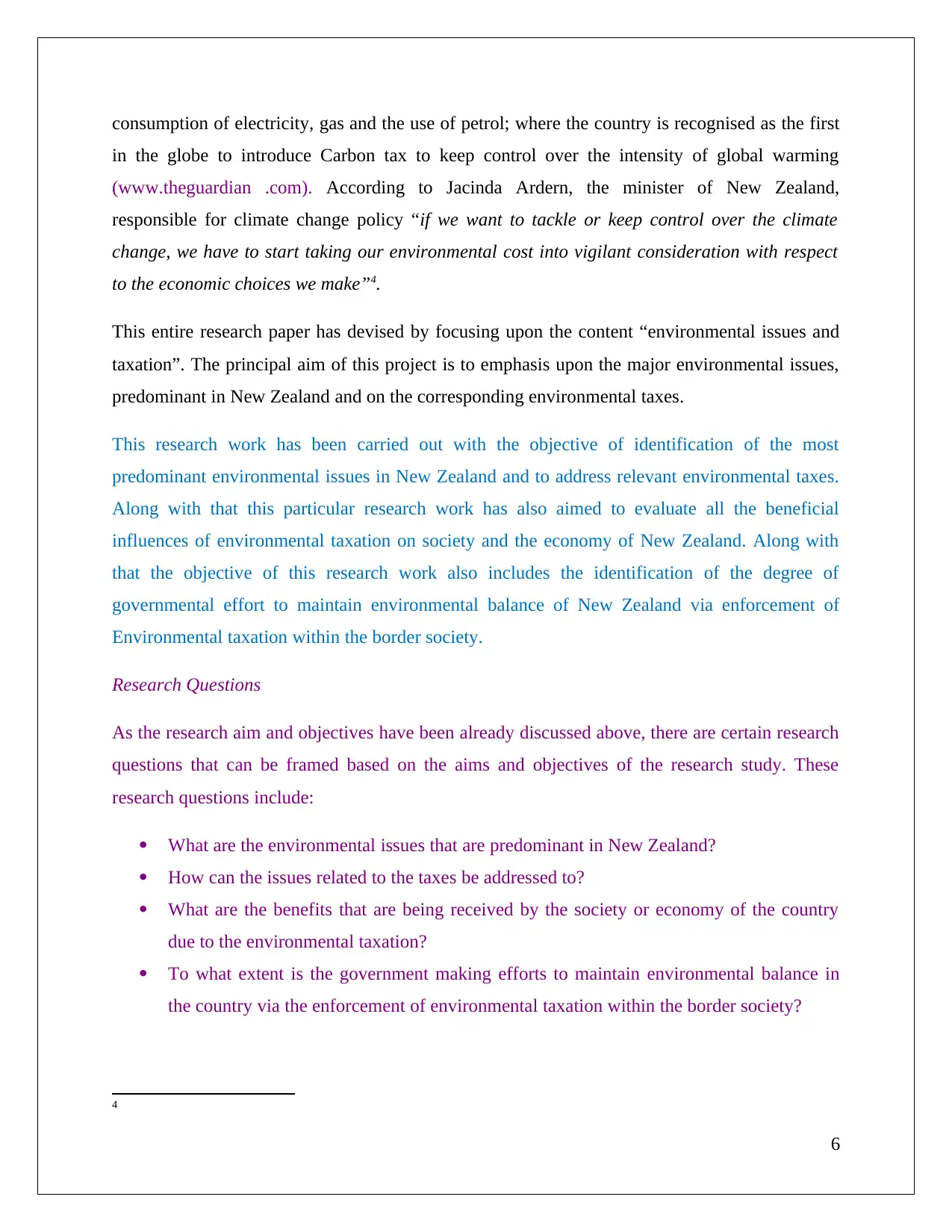
consumption of electricity, gas and the use of petrol; where the country is recognised as the first
in the globe to introduce Carbon tax to keep control over the intensity of global warming
(www.theguardian .com). According to Jacinda Ardern, the minister of New Zealand,
responsible for climate change policy “if we want to tackle or keep control over the climate
change, we have to start taking our environmental cost into vigilant consideration with respect
to the economic choices we make”4.
This entire research paper has devised by focusing upon the content “environmental issues and
taxation”. The principal aim of this project is to emphasis upon the major environmental issues,
predominant in New Zealand and on the corresponding environmental taxes.
This research work has been carried out with the objective of identification of the most
predominant environmental issues in New Zealand and to address relevant environmental taxes.
Along with that this particular research work has also aimed to evaluate all the beneficial
influences of environmental taxation on society and the economy of New Zealand. Along with
that the objective of this research work also includes the identification of the degree of
governmental effort to maintain environmental balance of New Zealand via enforcement of
Environmental taxation within the border society.
Research Questions
As the research aim and objectives have been already discussed above, there are certain research
questions that can be framed based on the aims and objectives of the research study. These
research questions include:
What are the environmental issues that are predominant in New Zealand?
How can the issues related to the taxes be addressed to?
What are the benefits that are being received by the society or economy of the country
due to the environmental taxation?
To what extent is the government making efforts to maintain environmental balance in
the country via the enforcement of environmental taxation within the border society?
4
6
in the globe to introduce Carbon tax to keep control over the intensity of global warming
(www.theguardian .com). According to Jacinda Ardern, the minister of New Zealand,
responsible for climate change policy “if we want to tackle or keep control over the climate
change, we have to start taking our environmental cost into vigilant consideration with respect
to the economic choices we make”4.
This entire research paper has devised by focusing upon the content “environmental issues and
taxation”. The principal aim of this project is to emphasis upon the major environmental issues,
predominant in New Zealand and on the corresponding environmental taxes.
This research work has been carried out with the objective of identification of the most
predominant environmental issues in New Zealand and to address relevant environmental taxes.
Along with that this particular research work has also aimed to evaluate all the beneficial
influences of environmental taxation on society and the economy of New Zealand. Along with
that the objective of this research work also includes the identification of the degree of
governmental effort to maintain environmental balance of New Zealand via enforcement of
Environmental taxation within the border society.
Research Questions
As the research aim and objectives have been already discussed above, there are certain research
questions that can be framed based on the aims and objectives of the research study. These
research questions include:
What are the environmental issues that are predominant in New Zealand?
How can the issues related to the taxes be addressed to?
What are the benefits that are being received by the society or economy of the country
due to the environmental taxation?
To what extent is the government making efforts to maintain environmental balance in
the country via the enforcement of environmental taxation within the border society?
4
6
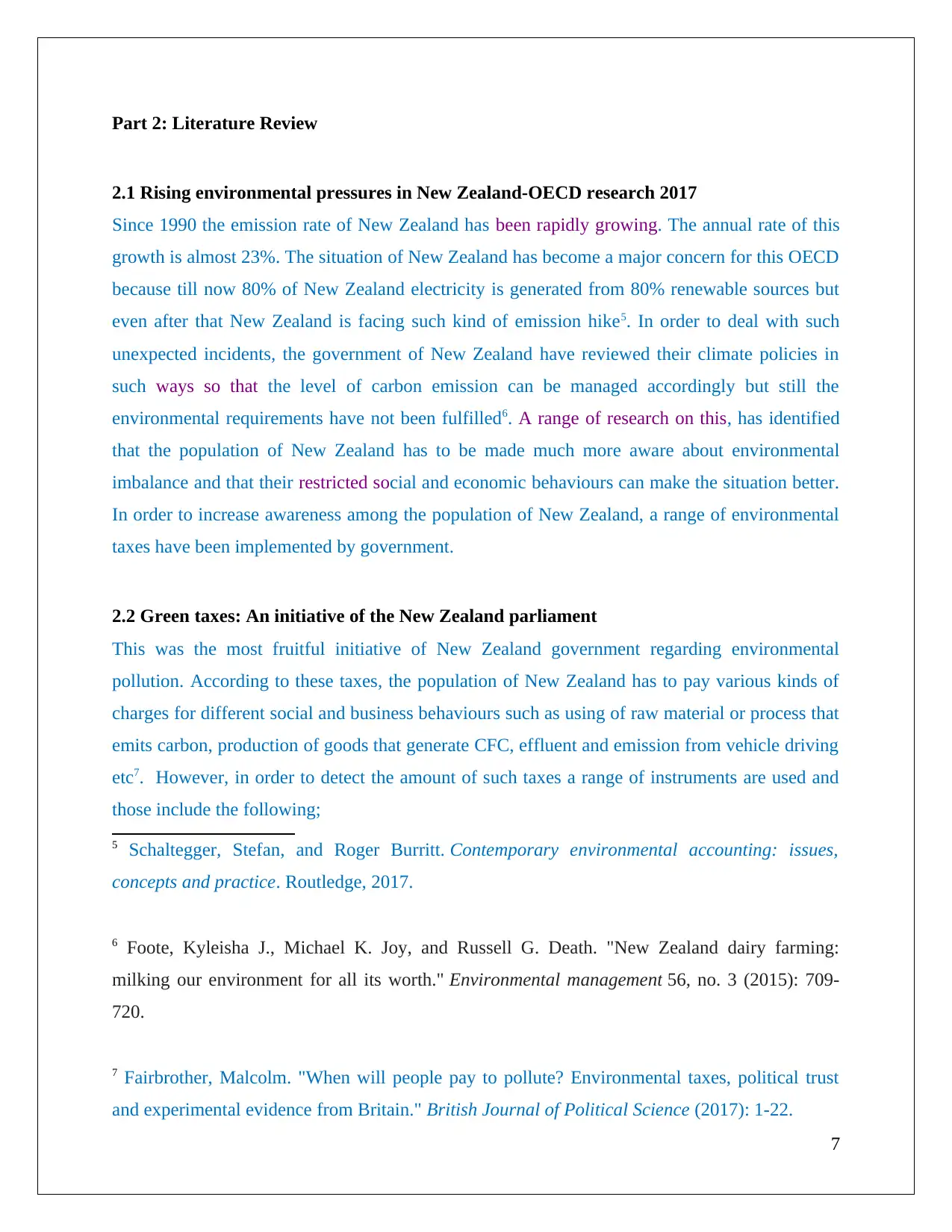
Part 2: Literature Review
2.1 Rising environmental pressures in New Zealand-OECD research 2017
Since 1990 the emission rate of New Zealand has been rapidly growing. The annual rate of this
growth is almost 23%. The situation of New Zealand has become a major concern for this OECD
because till now 80% of New Zealand electricity is generated from 80% renewable sources but
even after that New Zealand is facing such kind of emission hike5. In order to deal with such
unexpected incidents, the government of New Zealand have reviewed their climate policies in
such ways so that the level of carbon emission can be managed accordingly but still the
environmental requirements have not been fulfilled6. A range of research on this, has identified
that the population of New Zealand has to be made much more aware about environmental
imbalance and that their restricted social and economic behaviours can make the situation better.
In order to increase awareness among the population of New Zealand, a range of environmental
taxes have been implemented by government.
2.2 Green taxes: An initiative of the New Zealand parliament
This was the most fruitful initiative of New Zealand government regarding environmental
pollution. According to these taxes, the population of New Zealand has to pay various kinds of
charges for different social and business behaviours such as using of raw material or process that
emits carbon, production of goods that generate CFC, effluent and emission from vehicle driving
etc7. However, in order to detect the amount of such taxes a range of instruments are used and
those include the following;
5 Schaltegger, Stefan, and Roger Burritt. Contemporary environmental accounting: issues,
concepts and practice. Routledge, 2017.
6 Foote, Kyleisha J., Michael K. Joy, and Russell G. Death. "New Zealand dairy farming:
milking our environment for all its worth." Environmental management 56, no. 3 (2015): 709-
720.
7 Fairbrother, Malcolm. "When will people pay to pollute? Environmental taxes, political trust
and experimental evidence from Britain." British Journal of Political Science (2017): 1-22.
7
2.1 Rising environmental pressures in New Zealand-OECD research 2017
Since 1990 the emission rate of New Zealand has been rapidly growing. The annual rate of this
growth is almost 23%. The situation of New Zealand has become a major concern for this OECD
because till now 80% of New Zealand electricity is generated from 80% renewable sources but
even after that New Zealand is facing such kind of emission hike5. In order to deal with such
unexpected incidents, the government of New Zealand have reviewed their climate policies in
such ways so that the level of carbon emission can be managed accordingly but still the
environmental requirements have not been fulfilled6. A range of research on this, has identified
that the population of New Zealand has to be made much more aware about environmental
imbalance and that their restricted social and economic behaviours can make the situation better.
In order to increase awareness among the population of New Zealand, a range of environmental
taxes have been implemented by government.
2.2 Green taxes: An initiative of the New Zealand parliament
This was the most fruitful initiative of New Zealand government regarding environmental
pollution. According to these taxes, the population of New Zealand has to pay various kinds of
charges for different social and business behaviours such as using of raw material or process that
emits carbon, production of goods that generate CFC, effluent and emission from vehicle driving
etc7. However, in order to detect the amount of such taxes a range of instruments are used and
those include the following;
5 Schaltegger, Stefan, and Roger Burritt. Contemporary environmental accounting: issues,
concepts and practice. Routledge, 2017.
6 Foote, Kyleisha J., Michael K. Joy, and Russell G. Death. "New Zealand dairy farming:
milking our environment for all its worth." Environmental management 56, no. 3 (2015): 709-
720.
7 Fairbrother, Malcolm. "When will people pay to pollute? Environmental taxes, political trust
and experimental evidence from Britain." British Journal of Political Science (2017): 1-22.
7
Paraphrase This Document
Need a fresh take? Get an instant paraphrase of this document with our AI Paraphraser
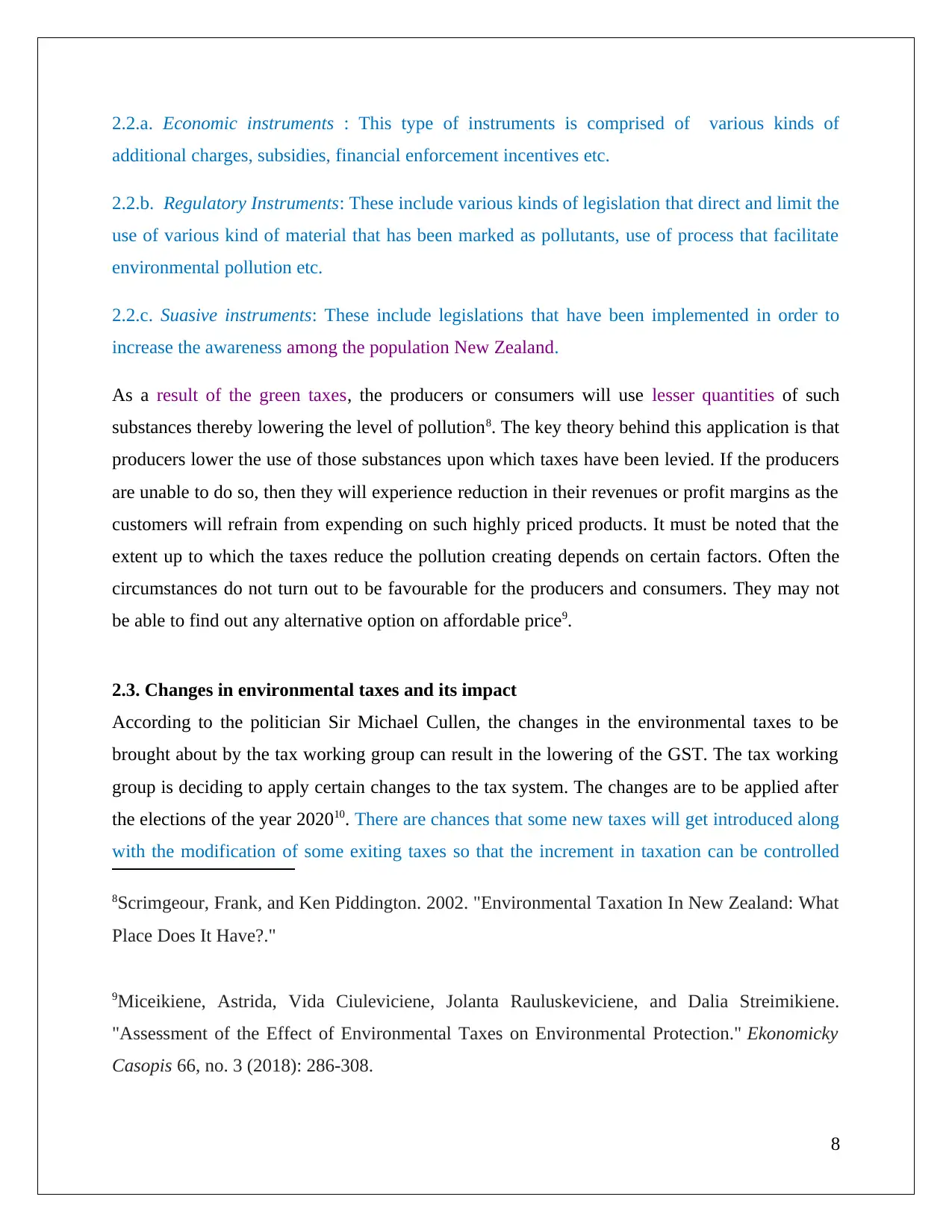
2.2.a. Economic instruments : This type of instruments is comprised of various kinds of
additional charges, subsidies, financial enforcement incentives etc.
2.2.b. Regulatory Instruments: These include various kinds of legislation that direct and limit the
use of various kind of material that has been marked as pollutants, use of process that facilitate
environmental pollution etc.
2.2.c. Suasive instruments: These include legislations that have been implemented in order to
increase the awareness among the population New Zealand.
As a result of the green taxes, the producers or consumers will use lesser quantities of such
substances thereby lowering the level of pollution8. The key theory behind this application is that
producers lower the use of those substances upon which taxes have been levied. If the producers
are unable to do so, then they will experience reduction in their revenues or profit margins as the
customers will refrain from expending on such highly priced products. It must be noted that the
extent up to which the taxes reduce the pollution creating depends on certain factors. Often the
circumstances do not turn out to be favourable for the producers and consumers. They may not
be able to find out any alternative option on affordable price9.
2.3. Changes in environmental taxes and its impact
According to the politician Sir Michael Cullen, the changes in the environmental taxes to be
brought about by the tax working group can result in the lowering of the GST. The tax working
group is deciding to apply certain changes to the tax system. The changes are to be applied after
the elections of the year 202010. There are chances that some new taxes will get introduced along
with the modification of some exiting taxes so that the increment in taxation can be controlled
8Scrimgeour, Frank, and Ken Piddington. 2002. "Environmental Taxation In New Zealand: What
Place Does It Have?."
9Miceikiene, Astrida, Vida Ciuleviciene, Jolanta Rauluskeviciene, and Dalia Streimikiene.
"Assessment of the Effect of Environmental Taxes on Environmental Protection." Ekonomicky
Casopis 66, no. 3 (2018): 286-308.
8
additional charges, subsidies, financial enforcement incentives etc.
2.2.b. Regulatory Instruments: These include various kinds of legislation that direct and limit the
use of various kind of material that has been marked as pollutants, use of process that facilitate
environmental pollution etc.
2.2.c. Suasive instruments: These include legislations that have been implemented in order to
increase the awareness among the population New Zealand.
As a result of the green taxes, the producers or consumers will use lesser quantities of such
substances thereby lowering the level of pollution8. The key theory behind this application is that
producers lower the use of those substances upon which taxes have been levied. If the producers
are unable to do so, then they will experience reduction in their revenues or profit margins as the
customers will refrain from expending on such highly priced products. It must be noted that the
extent up to which the taxes reduce the pollution creating depends on certain factors. Often the
circumstances do not turn out to be favourable for the producers and consumers. They may not
be able to find out any alternative option on affordable price9.
2.3. Changes in environmental taxes and its impact
According to the politician Sir Michael Cullen, the changes in the environmental taxes to be
brought about by the tax working group can result in the lowering of the GST. The tax working
group is deciding to apply certain changes to the tax system. The changes are to be applied after
the elections of the year 202010. There are chances that some new taxes will get introduced along
with the modification of some exiting taxes so that the increment in taxation can be controlled
8Scrimgeour, Frank, and Ken Piddington. 2002. "Environmental Taxation In New Zealand: What
Place Does It Have?."
9Miceikiene, Astrida, Vida Ciuleviciene, Jolanta Rauluskeviciene, and Dalia Streimikiene.
"Assessment of the Effect of Environmental Taxes on Environmental Protection." Ekonomicky
Casopis 66, no. 3 (2018): 286-308.
8
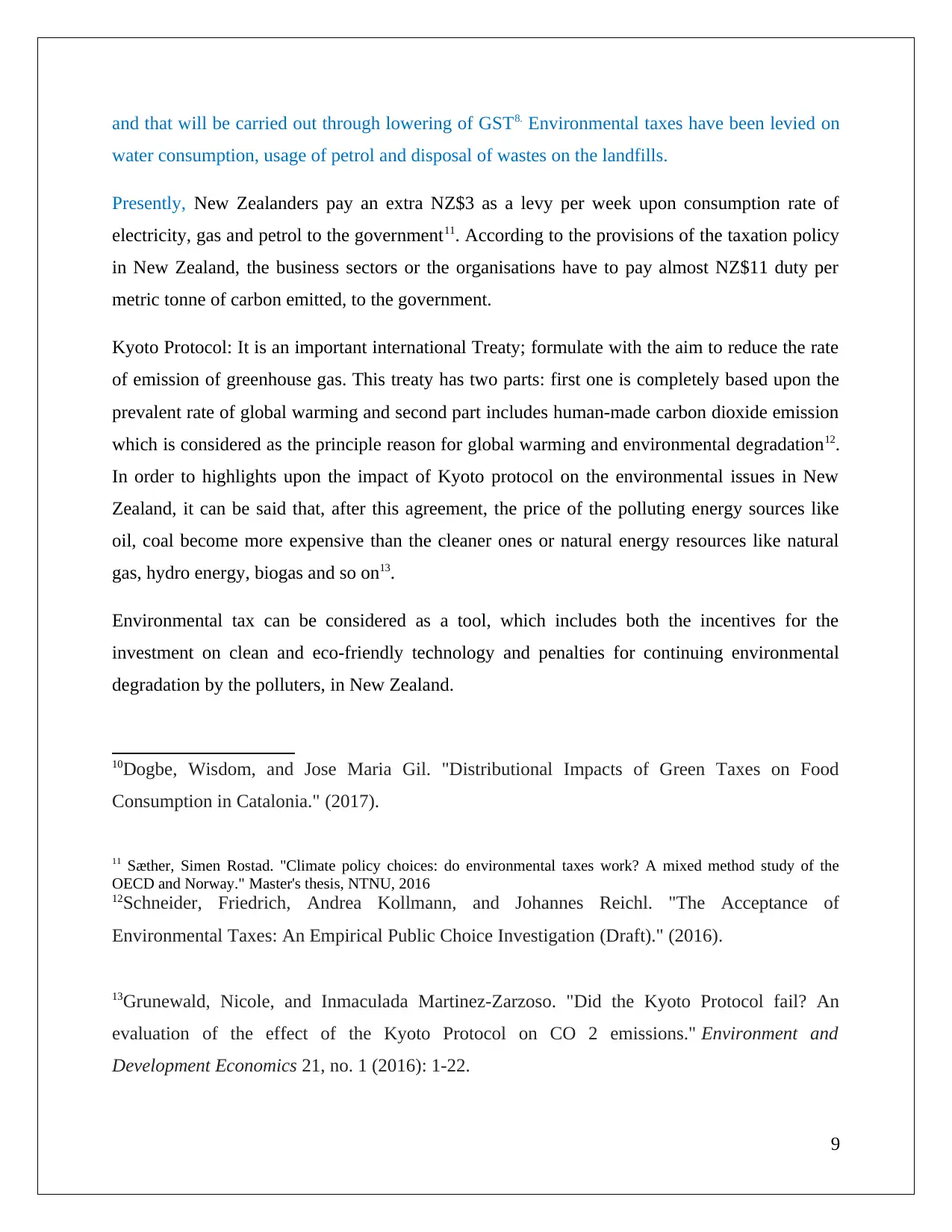
and that will be carried out through lowering of GST8. Environmental taxes have been levied on
water consumption, usage of petrol and disposal of wastes on the landfills.
Presently, New Zealanders pay an extra NZ$3 as a levy per week upon consumption rate of
electricity, gas and petrol to the government11. According to the provisions of the taxation policy
in New Zealand, the business sectors or the organisations have to pay almost NZ$11 duty per
metric tonne of carbon emitted, to the government.
Kyoto Protocol: It is an important international Treaty; formulate with the aim to reduce the rate
of emission of greenhouse gas. This treaty has two parts: first one is completely based upon the
prevalent rate of global warming and second part includes human-made carbon dioxide emission
which is considered as the principle reason for global warming and environmental degradation12.
In order to highlights upon the impact of Kyoto protocol on the environmental issues in New
Zealand, it can be said that, after this agreement, the price of the polluting energy sources like
oil, coal become more expensive than the cleaner ones or natural energy resources like natural
gas, hydro energy, biogas and so on13.
Environmental tax can be considered as a tool, which includes both the incentives for the
investment on clean and eco-friendly technology and penalties for continuing environmental
degradation by the polluters, in New Zealand.
10Dogbe, Wisdom, and Jose Maria Gil. "Distributional Impacts of Green Taxes on Food
Consumption in Catalonia." (2017).
11 Sæther, Simen Rostad. "Climate policy choices: do environmental taxes work? A mixed method study of the
OECD and Norway." Master's thesis, NTNU, 2016
12Schneider, Friedrich, Andrea Kollmann, and Johannes Reichl. "The Acceptance of
Environmental Taxes: An Empirical Public Choice Investigation (Draft)." (2016).
13Grunewald, Nicole, and Inmaculada Martinez-Zarzoso. "Did the Kyoto Protocol fail? An
evaluation of the effect of the Kyoto Protocol on CO 2 emissions." Environment and
Development Economics 21, no. 1 (2016): 1-22.
9
water consumption, usage of petrol and disposal of wastes on the landfills.
Presently, New Zealanders pay an extra NZ$3 as a levy per week upon consumption rate of
electricity, gas and petrol to the government11. According to the provisions of the taxation policy
in New Zealand, the business sectors or the organisations have to pay almost NZ$11 duty per
metric tonne of carbon emitted, to the government.
Kyoto Protocol: It is an important international Treaty; formulate with the aim to reduce the rate
of emission of greenhouse gas. This treaty has two parts: first one is completely based upon the
prevalent rate of global warming and second part includes human-made carbon dioxide emission
which is considered as the principle reason for global warming and environmental degradation12.
In order to highlights upon the impact of Kyoto protocol on the environmental issues in New
Zealand, it can be said that, after this agreement, the price of the polluting energy sources like
oil, coal become more expensive than the cleaner ones or natural energy resources like natural
gas, hydro energy, biogas and so on13.
Environmental tax can be considered as a tool, which includes both the incentives for the
investment on clean and eco-friendly technology and penalties for continuing environmental
degradation by the polluters, in New Zealand.
10Dogbe, Wisdom, and Jose Maria Gil. "Distributional Impacts of Green Taxes on Food
Consumption in Catalonia." (2017).
11 Sæther, Simen Rostad. "Climate policy choices: do environmental taxes work? A mixed method study of the
OECD and Norway." Master's thesis, NTNU, 2016
12Schneider, Friedrich, Andrea Kollmann, and Johannes Reichl. "The Acceptance of
Environmental Taxes: An Empirical Public Choice Investigation (Draft)." (2016).
13Grunewald, Nicole, and Inmaculada Martinez-Zarzoso. "Did the Kyoto Protocol fail? An
evaluation of the effect of the Kyoto Protocol on CO 2 emissions." Environment and
Development Economics 21, no. 1 (2016): 1-22.
9
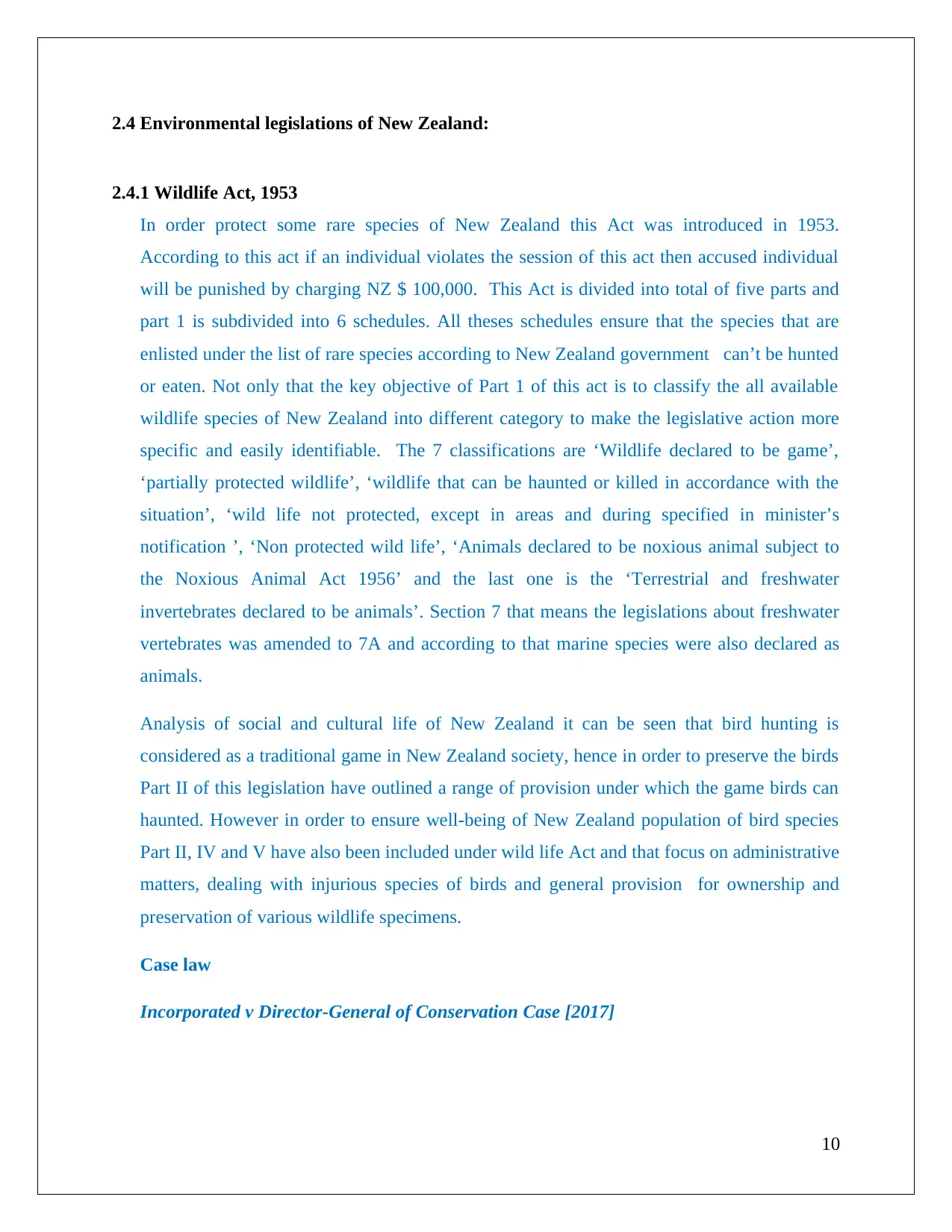
2.4 Environmental legislations of New Zealand:
2.4.1 Wildlife Act, 1953
In order protect some rare species of New Zealand this Act was introduced in 1953.
According to this act if an individual violates the session of this act then accused individual
will be punished by charging NZ $ 100,000. This Act is divided into total of five parts and
part 1 is subdivided into 6 schedules. All theses schedules ensure that the species that are
enlisted under the list of rare species according to New Zealand government can’t be hunted
or eaten. Not only that the key objective of Part 1 of this act is to classify the all available
wildlife species of New Zealand into different category to make the legislative action more
specific and easily identifiable. The 7 classifications are ‘Wildlife declared to be game’,
‘partially protected wildlife’, ‘wildlife that can be haunted or killed in accordance with the
situation’, ‘wild life not protected, except in areas and during specified in minister’s
notification ’, ‘Non protected wild life’, ‘Animals declared to be noxious animal subject to
the Noxious Animal Act 1956’ and the last one is the ‘Terrestrial and freshwater
invertebrates declared to be animals’. Section 7 that means the legislations about freshwater
vertebrates was amended to 7A and according to that marine species were also declared as
animals.
Analysis of social and cultural life of New Zealand it can be seen that bird hunting is
considered as a traditional game in New Zealand society, hence in order to preserve the birds
Part II of this legislation have outlined a range of provision under which the game birds can
haunted. However in order to ensure well-being of New Zealand population of bird species
Part II, IV and V have also been included under wild life Act and that focus on administrative
matters, dealing with injurious species of birds and general provision for ownership and
preservation of various wildlife specimens.
Case law
Incorporated v Director-General of Conservation Case [2017]
10
2.4.1 Wildlife Act, 1953
In order protect some rare species of New Zealand this Act was introduced in 1953.
According to this act if an individual violates the session of this act then accused individual
will be punished by charging NZ $ 100,000. This Act is divided into total of five parts and
part 1 is subdivided into 6 schedules. All theses schedules ensure that the species that are
enlisted under the list of rare species according to New Zealand government can’t be hunted
or eaten. Not only that the key objective of Part 1 of this act is to classify the all available
wildlife species of New Zealand into different category to make the legislative action more
specific and easily identifiable. The 7 classifications are ‘Wildlife declared to be game’,
‘partially protected wildlife’, ‘wildlife that can be haunted or killed in accordance with the
situation’, ‘wild life not protected, except in areas and during specified in minister’s
notification ’, ‘Non protected wild life’, ‘Animals declared to be noxious animal subject to
the Noxious Animal Act 1956’ and the last one is the ‘Terrestrial and freshwater
invertebrates declared to be animals’. Section 7 that means the legislations about freshwater
vertebrates was amended to 7A and according to that marine species were also declared as
animals.
Analysis of social and cultural life of New Zealand it can be seen that bird hunting is
considered as a traditional game in New Zealand society, hence in order to preserve the birds
Part II of this legislation have outlined a range of provision under which the game birds can
haunted. However in order to ensure well-being of New Zealand population of bird species
Part II, IV and V have also been included under wild life Act and that focus on administrative
matters, dealing with injurious species of birds and general provision for ownership and
preservation of various wildlife specimens.
Case law
Incorporated v Director-General of Conservation Case [2017]
10
Secure Best Marks with AI Grader
Need help grading? Try our AI Grader for instant feedback on your assignments.
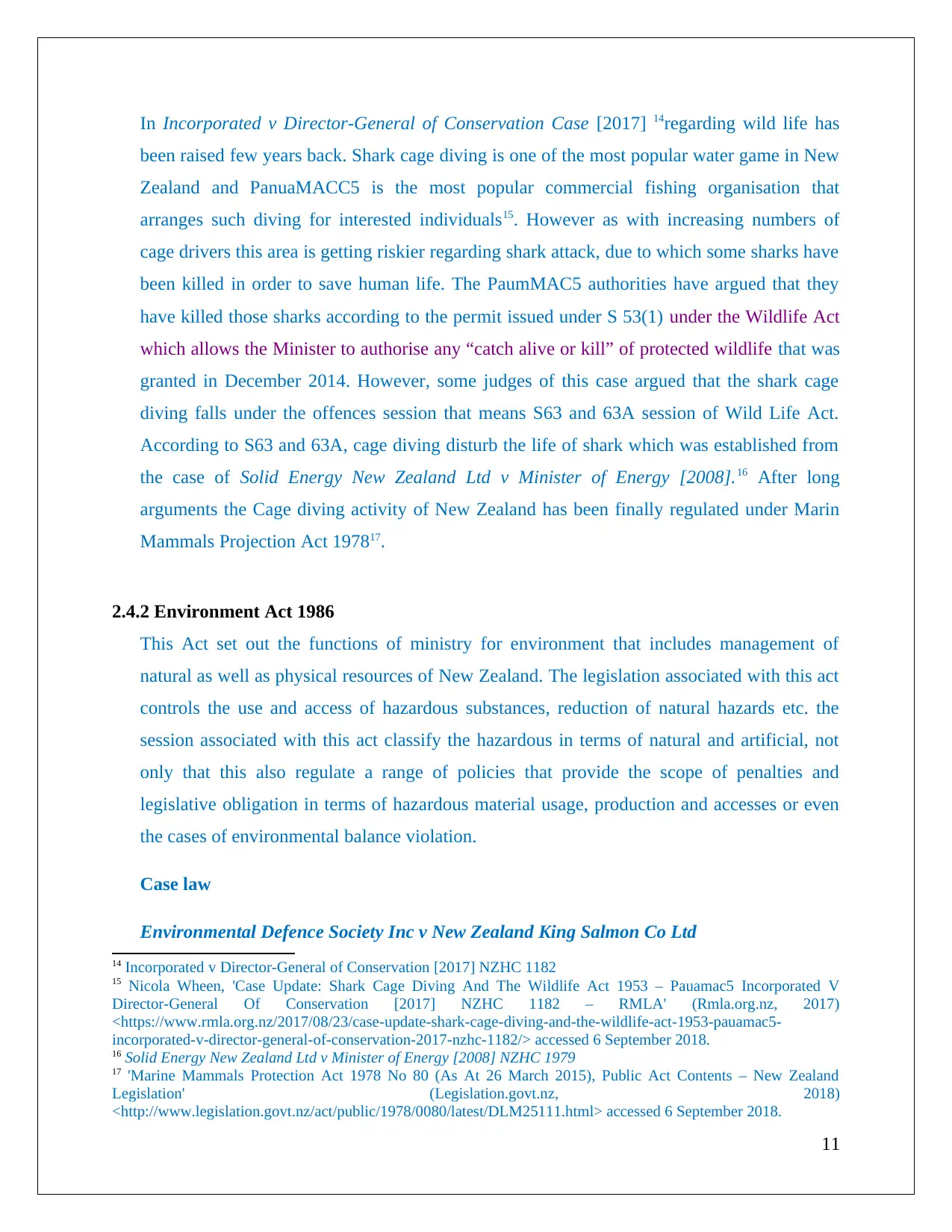
In Incorporated v Director-General of Conservation Case [2017] 14regarding wild life has
been raised few years back. Shark cage diving is one of the most popular water game in New
Zealand and PanuaMACC5 is the most popular commercial fishing organisation that
arranges such diving for interested individuals15. However as with increasing numbers of
cage drivers this area is getting riskier regarding shark attack, due to which some sharks have
been killed in order to save human life. The PaumMAC5 authorities have argued that they
have killed those sharks according to the permit issued under S 53(1) under the Wildlife Act
which allows the Minister to authorise any “catch alive or kill” of protected wildlife that was
granted in December 2014. However, some judges of this case argued that the shark cage
diving falls under the offences session that means S63 and 63A session of Wild Life Act.
According to S63 and 63A, cage diving disturb the life of shark which was established from
the case of Solid Energy New Zealand Ltd v Minister of Energy [2008].16 After long
arguments the Cage diving activity of New Zealand has been finally regulated under Marin
Mammals Projection Act 197817.
2.4.2 Environment Act 1986
This Act set out the functions of ministry for environment that includes management of
natural as well as physical resources of New Zealand. The legislation associated with this act
controls the use and access of hazardous substances, reduction of natural hazards etc. the
session associated with this act classify the hazardous in terms of natural and artificial, not
only that this also regulate a range of policies that provide the scope of penalties and
legislative obligation in terms of hazardous material usage, production and accesses or even
the cases of environmental balance violation.
Case law
Environmental Defence Society Inc v New Zealand King Salmon Co Ltd
14 Incorporated v Director-General of Conservation [2017] NZHC 1182
15 Nicola Wheen, 'Case Update: Shark Cage Diving And The Wildlife Act 1953 – Pauamac5 Incorporated V
Director-General Of Conservation [2017] NZHC 1182 – RMLA' (Rmla.org.nz, 2017)
<https://www.rmla.org.nz/2017/08/23/case-update-shark-cage-diving-and-the-wildlife-act-1953-pauamac5-
incorporated-v-director-general-of-conservation-2017-nzhc-1182/> accessed 6 September 2018.
16 Solid Energy New Zealand Ltd v Minister of Energy [2008] NZHC 1979
17 'Marine Mammals Protection Act 1978 No 80 (As At 26 March 2015), Public Act Contents – New Zealand
Legislation' (Legislation.govt.nz, 2018)
<http://www.legislation.govt.nz/act/public/1978/0080/latest/DLM25111.html> accessed 6 September 2018.
11
been raised few years back. Shark cage diving is one of the most popular water game in New
Zealand and PanuaMACC5 is the most popular commercial fishing organisation that
arranges such diving for interested individuals15. However as with increasing numbers of
cage drivers this area is getting riskier regarding shark attack, due to which some sharks have
been killed in order to save human life. The PaumMAC5 authorities have argued that they
have killed those sharks according to the permit issued under S 53(1) under the Wildlife Act
which allows the Minister to authorise any “catch alive or kill” of protected wildlife that was
granted in December 2014. However, some judges of this case argued that the shark cage
diving falls under the offences session that means S63 and 63A session of Wild Life Act.
According to S63 and 63A, cage diving disturb the life of shark which was established from
the case of Solid Energy New Zealand Ltd v Minister of Energy [2008].16 After long
arguments the Cage diving activity of New Zealand has been finally regulated under Marin
Mammals Projection Act 197817.
2.4.2 Environment Act 1986
This Act set out the functions of ministry for environment that includes management of
natural as well as physical resources of New Zealand. The legislation associated with this act
controls the use and access of hazardous substances, reduction of natural hazards etc. the
session associated with this act classify the hazardous in terms of natural and artificial, not
only that this also regulate a range of policies that provide the scope of penalties and
legislative obligation in terms of hazardous material usage, production and accesses or even
the cases of environmental balance violation.
Case law
Environmental Defence Society Inc v New Zealand King Salmon Co Ltd
14 Incorporated v Director-General of Conservation [2017] NZHC 1182
15 Nicola Wheen, 'Case Update: Shark Cage Diving And The Wildlife Act 1953 – Pauamac5 Incorporated V
Director-General Of Conservation [2017] NZHC 1182 – RMLA' (Rmla.org.nz, 2017)
<https://www.rmla.org.nz/2017/08/23/case-update-shark-cage-diving-and-the-wildlife-act-1953-pauamac5-
incorporated-v-director-general-of-conservation-2017-nzhc-1182/> accessed 6 September 2018.
16 Solid Energy New Zealand Ltd v Minister of Energy [2008] NZHC 1979
17 'Marine Mammals Protection Act 1978 No 80 (As At 26 March 2015), Public Act Contents – New Zealand
Legislation' (Legislation.govt.nz, 2018)
<http://www.legislation.govt.nz/act/public/1978/0080/latest/DLM25111.html> accessed 6 September 2018.
11
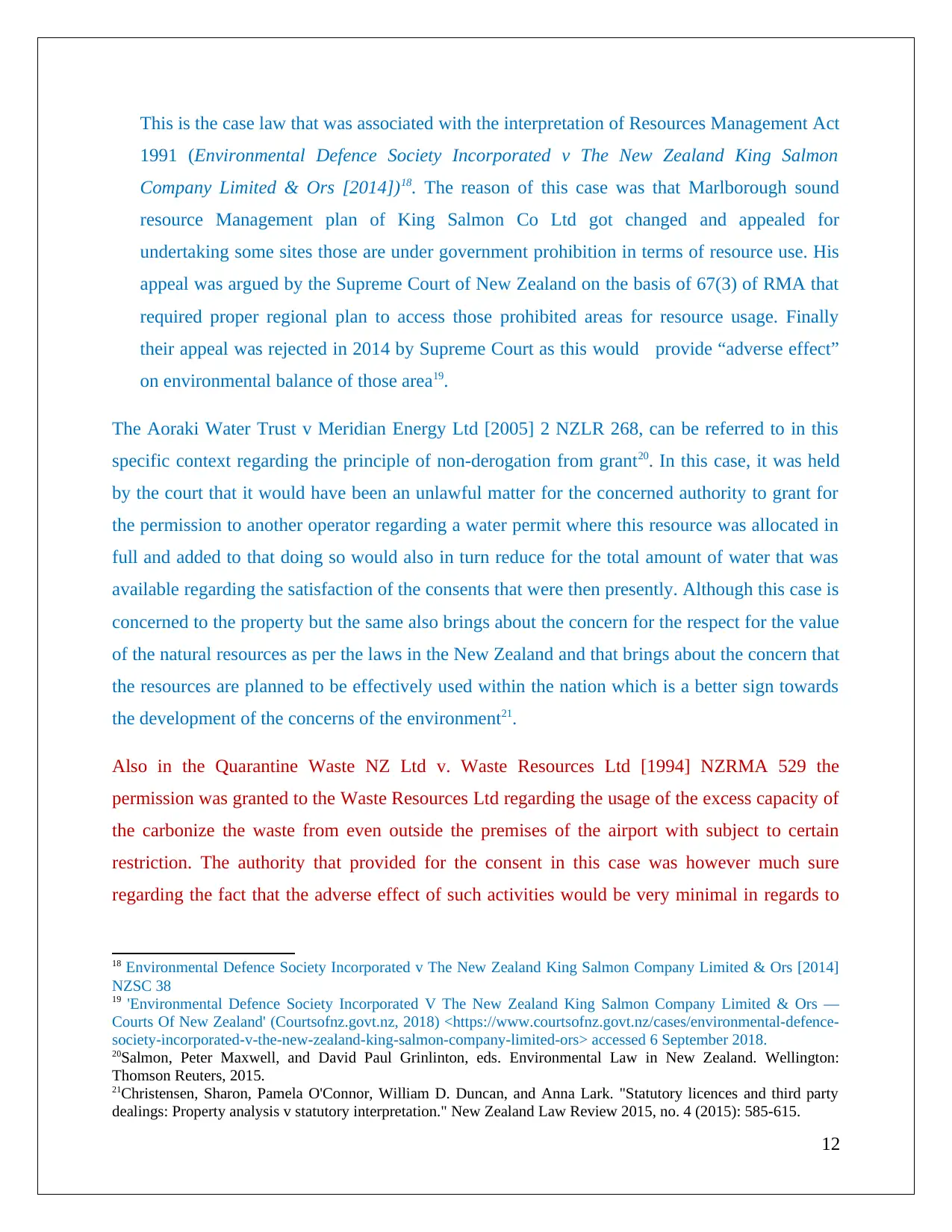
This is the case law that was associated with the interpretation of Resources Management Act
1991 (Environmental Defence Society Incorporated v The New Zealand King Salmon
Company Limited & Ors [2014])18. The reason of this case was that Marlborough sound
resource Management plan of King Salmon Co Ltd got changed and appealed for
undertaking some sites those are under government prohibition in terms of resource use. His
appeal was argued by the Supreme Court of New Zealand on the basis of 67(3) of RMA that
required proper regional plan to access those prohibited areas for resource usage. Finally
their appeal was rejected in 2014 by Supreme Court as this would provide “adverse effect”
on environmental balance of those area19.
The Aoraki Water Trust v Meridian Energy Ltd [2005] 2 NZLR 268, can be referred to in this
specific context regarding the principle of non-derogation from grant20. In this case, it was held
by the court that it would have been an unlawful matter for the concerned authority to grant for
the permission to another operator regarding a water permit where this resource was allocated in
full and added to that doing so would also in turn reduce for the total amount of water that was
available regarding the satisfaction of the consents that were then presently. Although this case is
concerned to the property but the same also brings about the concern for the respect for the value
of the natural resources as per the laws in the New Zealand and that brings about the concern that
the resources are planned to be effectively used within the nation which is a better sign towards
the development of the concerns of the environment21.
Also in the Quarantine Waste NZ Ltd v. Waste Resources Ltd [1994] NZRMA 529 the
permission was granted to the Waste Resources Ltd regarding the usage of the excess capacity of
the carbonize the waste from even outside the premises of the airport with subject to certain
restriction. The authority that provided for the consent in this case was however much sure
regarding the fact that the adverse effect of such activities would be very minimal in regards to
18 Environmental Defence Society Incorporated v The New Zealand King Salmon Company Limited & Ors [2014]
NZSC 38
19 'Environmental Defence Society Incorporated V The New Zealand King Salmon Company Limited & Ors —
Courts Of New Zealand' (Courtsofnz.govt.nz, 2018) <https://www.courtsofnz.govt.nz/cases/environmental-defence-
society-incorporated-v-the-new-zealand-king-salmon-company-limited-ors> accessed 6 September 2018.
20Salmon, Peter Maxwell, and David Paul Grinlinton, eds. Environmental Law in New Zealand. Wellington:
Thomson Reuters, 2015.
21Christensen, Sharon, Pamela O'Connor, William D. Duncan, and Anna Lark. "Statutory licences and third party
dealings: Property analysis v statutory interpretation." New Zealand Law Review 2015, no. 4 (2015): 585-615.
12
1991 (Environmental Defence Society Incorporated v The New Zealand King Salmon
Company Limited & Ors [2014])18. The reason of this case was that Marlborough sound
resource Management plan of King Salmon Co Ltd got changed and appealed for
undertaking some sites those are under government prohibition in terms of resource use. His
appeal was argued by the Supreme Court of New Zealand on the basis of 67(3) of RMA that
required proper regional plan to access those prohibited areas for resource usage. Finally
their appeal was rejected in 2014 by Supreme Court as this would provide “adverse effect”
on environmental balance of those area19.
The Aoraki Water Trust v Meridian Energy Ltd [2005] 2 NZLR 268, can be referred to in this
specific context regarding the principle of non-derogation from grant20. In this case, it was held
by the court that it would have been an unlawful matter for the concerned authority to grant for
the permission to another operator regarding a water permit where this resource was allocated in
full and added to that doing so would also in turn reduce for the total amount of water that was
available regarding the satisfaction of the consents that were then presently. Although this case is
concerned to the property but the same also brings about the concern for the respect for the value
of the natural resources as per the laws in the New Zealand and that brings about the concern that
the resources are planned to be effectively used within the nation which is a better sign towards
the development of the concerns of the environment21.
Also in the Quarantine Waste NZ Ltd v. Waste Resources Ltd [1994] NZRMA 529 the
permission was granted to the Waste Resources Ltd regarding the usage of the excess capacity of
the carbonize the waste from even outside the premises of the airport with subject to certain
restriction. The authority that provided for the consent in this case was however much sure
regarding the fact that the adverse effect of such activities would be very minimal in regards to
18 Environmental Defence Society Incorporated v The New Zealand King Salmon Company Limited & Ors [2014]
NZSC 38
19 'Environmental Defence Society Incorporated V The New Zealand King Salmon Company Limited & Ors —
Courts Of New Zealand' (Courtsofnz.govt.nz, 2018) <https://www.courtsofnz.govt.nz/cases/environmental-defence-
society-incorporated-v-the-new-zealand-king-salmon-company-limited-ors> accessed 6 September 2018.
20Salmon, Peter Maxwell, and David Paul Grinlinton, eds. Environmental Law in New Zealand. Wellington:
Thomson Reuters, 2015.
21Christensen, Sharon, Pamela O'Connor, William D. Duncan, and Anna Lark. "Statutory licences and third party
dealings: Property analysis v statutory interpretation." New Zealand Law Review 2015, no. 4 (2015): 585-615.
12
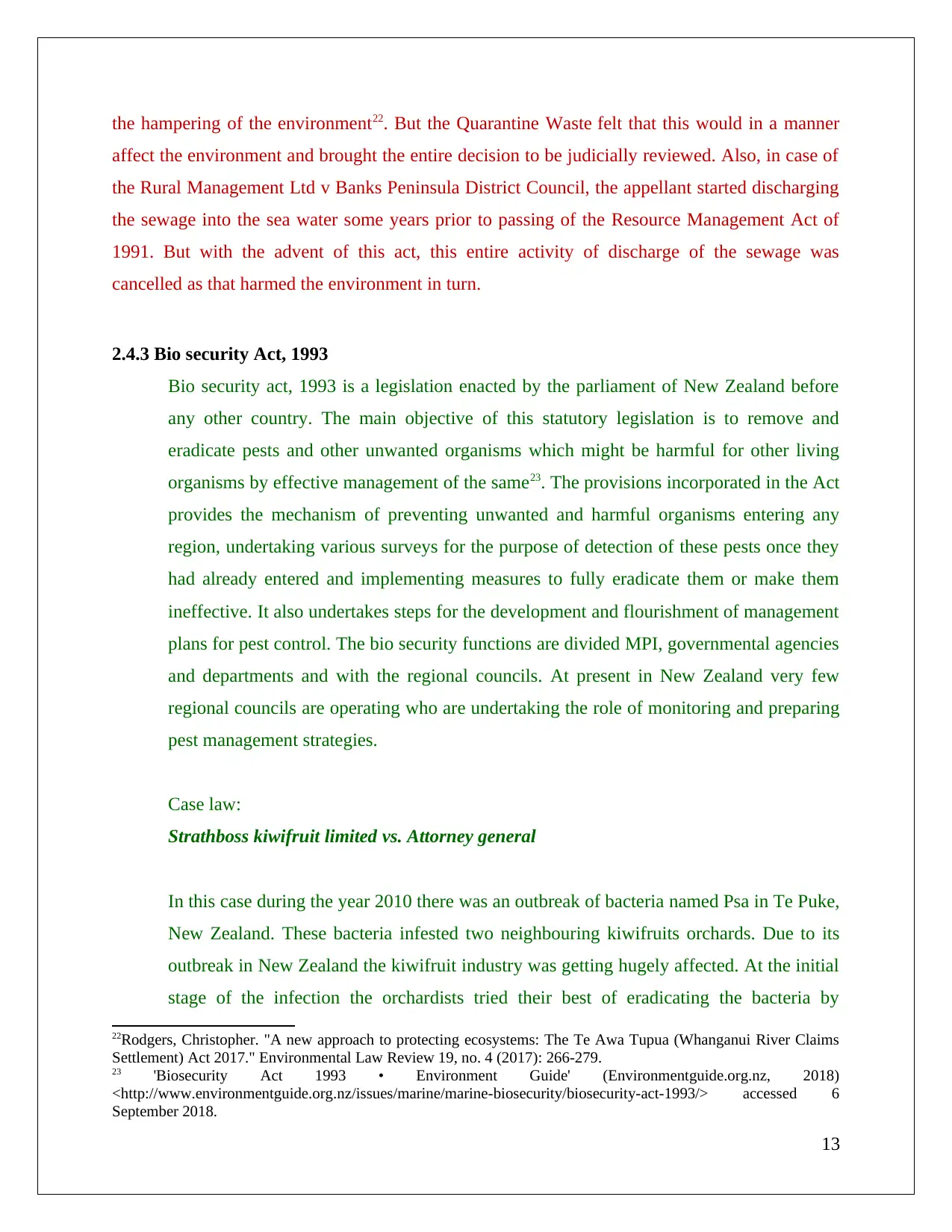
the hampering of the environment22. But the Quarantine Waste felt that this would in a manner
affect the environment and brought the entire decision to be judicially reviewed. Also, in case of
the Rural Management Ltd v Banks Peninsula District Council, the appellant started discharging
the sewage into the sea water some years prior to passing of the Resource Management Act of
1991. But with the advent of this act, this entire activity of discharge of the sewage was
cancelled as that harmed the environment in turn.
2.4.3 Bio security Act, 1993
Bio security act, 1993 is a legislation enacted by the parliament of New Zealand before
any other country. The main objective of this statutory legislation is to remove and
eradicate pests and other unwanted organisms which might be harmful for other living
organisms by effective management of the same23. The provisions incorporated in the Act
provides the mechanism of preventing unwanted and harmful organisms entering any
region, undertaking various surveys for the purpose of detection of these pests once they
had already entered and implementing measures to fully eradicate them or make them
ineffective. It also undertakes steps for the development and flourishment of management
plans for pest control. The bio security functions are divided MPI, governmental agencies
and departments and with the regional councils. At present in New Zealand very few
regional councils are operating who are undertaking the role of monitoring and preparing
pest management strategies.
Case law:
Strathboss kiwifruit limited vs. Attorney general
In this case during the year 2010 there was an outbreak of bacteria named Psa in Te Puke,
New Zealand. These bacteria infested two neighbouring kiwifruits orchards. Due to its
outbreak in New Zealand the kiwifruit industry was getting hugely affected. At the initial
stage of the infection the orchardists tried their best of eradicating the bacteria by
22Rodgers, Christopher. "A new approach to protecting ecosystems: The Te Awa Tupua (Whanganui River Claims
Settlement) Act 2017." Environmental Law Review 19, no. 4 (2017): 266-279.
23 'Biosecurity Act 1993 • Environment Guide' (Environmentguide.org.nz, 2018)
<http://www.environmentguide.org.nz/issues/marine/marine-biosecurity/biosecurity-act-1993/> accessed 6
September 2018.
13
affect the environment and brought the entire decision to be judicially reviewed. Also, in case of
the Rural Management Ltd v Banks Peninsula District Council, the appellant started discharging
the sewage into the sea water some years prior to passing of the Resource Management Act of
1991. But with the advent of this act, this entire activity of discharge of the sewage was
cancelled as that harmed the environment in turn.
2.4.3 Bio security Act, 1993
Bio security act, 1993 is a legislation enacted by the parliament of New Zealand before
any other country. The main objective of this statutory legislation is to remove and
eradicate pests and other unwanted organisms which might be harmful for other living
organisms by effective management of the same23. The provisions incorporated in the Act
provides the mechanism of preventing unwanted and harmful organisms entering any
region, undertaking various surveys for the purpose of detection of these pests once they
had already entered and implementing measures to fully eradicate them or make them
ineffective. It also undertakes steps for the development and flourishment of management
plans for pest control. The bio security functions are divided MPI, governmental agencies
and departments and with the regional councils. At present in New Zealand very few
regional councils are operating who are undertaking the role of monitoring and preparing
pest management strategies.
Case law:
Strathboss kiwifruit limited vs. Attorney general
In this case during the year 2010 there was an outbreak of bacteria named Psa in Te Puke,
New Zealand. These bacteria infested two neighbouring kiwifruits orchards. Due to its
outbreak in New Zealand the kiwifruit industry was getting hugely affected. At the initial
stage of the infection the orchardists tried their best of eradicating the bacteria by
22Rodgers, Christopher. "A new approach to protecting ecosystems: The Te Awa Tupua (Whanganui River Claims
Settlement) Act 2017." Environmental Law Review 19, no. 4 (2017): 266-279.
23 'Biosecurity Act 1993 • Environment Guide' (Environmentguide.org.nz, 2018)
<http://www.environmentguide.org.nz/issues/marine/marine-biosecurity/biosecurity-act-1993/> accessed 6
September 2018.
13
Paraphrase This Document
Need a fresh take? Get an instant paraphrase of this document with our AI Paraphraser
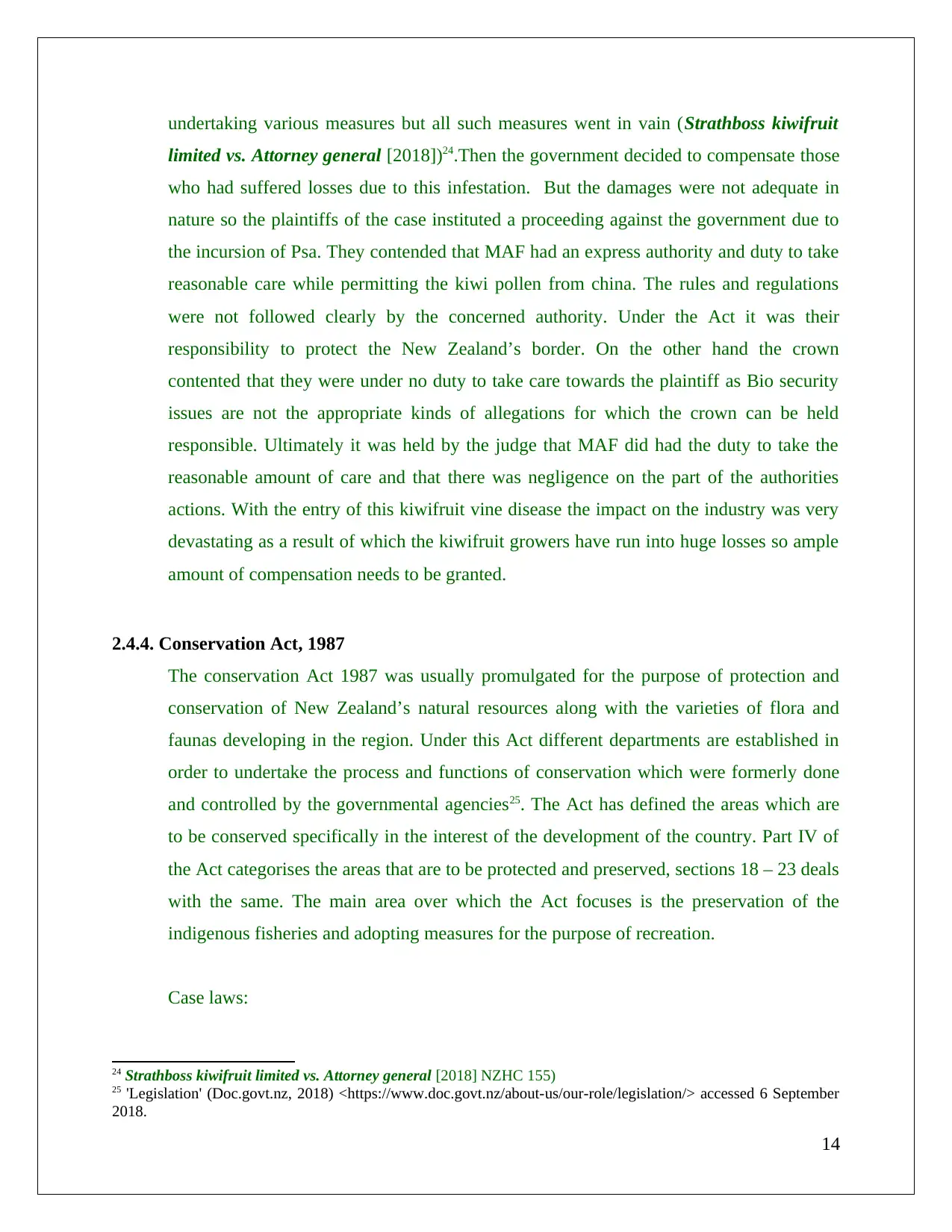
undertaking various measures but all such measures went in vain (Strathboss kiwifruit
limited vs. Attorney general [2018])24.Then the government decided to compensate those
who had suffered losses due to this infestation. But the damages were not adequate in
nature so the plaintiffs of the case instituted a proceeding against the government due to
the incursion of Psa. They contended that MAF had an express authority and duty to take
reasonable care while permitting the kiwi pollen from china. The rules and regulations
were not followed clearly by the concerned authority. Under the Act it was their
responsibility to protect the New Zealand’s border. On the other hand the crown
contented that they were under no duty to take care towards the plaintiff as Bio security
issues are not the appropriate kinds of allegations for which the crown can be held
responsible. Ultimately it was held by the judge that MAF did had the duty to take the
reasonable amount of care and that there was negligence on the part of the authorities
actions. With the entry of this kiwifruit vine disease the impact on the industry was very
devastating as a result of which the kiwifruit growers have run into huge losses so ample
amount of compensation needs to be granted.
2.4.4. Conservation Act, 1987
The conservation Act 1987 was usually promulgated for the purpose of protection and
conservation of New Zealand’s natural resources along with the varieties of flora and
faunas developing in the region. Under this Act different departments are established in
order to undertake the process and functions of conservation which were formerly done
and controlled by the governmental agencies25. The Act has defined the areas which are
to be conserved specifically in the interest of the development of the country. Part IV of
the Act categorises the areas that are to be protected and preserved, sections 18 – 23 deals
with the same. The main area over which the Act focuses is the preservation of the
indigenous fisheries and adopting measures for the purpose of recreation.
Case laws:
24 Strathboss kiwifruit limited vs. Attorney general [2018] NZHC 155)
25 'Legislation' (Doc.govt.nz, 2018) <https://www.doc.govt.nz/about-us/our-role/legislation/> accessed 6 September
2018.
14
limited vs. Attorney general [2018])24.Then the government decided to compensate those
who had suffered losses due to this infestation. But the damages were not adequate in
nature so the plaintiffs of the case instituted a proceeding against the government due to
the incursion of Psa. They contended that MAF had an express authority and duty to take
reasonable care while permitting the kiwi pollen from china. The rules and regulations
were not followed clearly by the concerned authority. Under the Act it was their
responsibility to protect the New Zealand’s border. On the other hand the crown
contented that they were under no duty to take care towards the plaintiff as Bio security
issues are not the appropriate kinds of allegations for which the crown can be held
responsible. Ultimately it was held by the judge that MAF did had the duty to take the
reasonable amount of care and that there was negligence on the part of the authorities
actions. With the entry of this kiwifruit vine disease the impact on the industry was very
devastating as a result of which the kiwifruit growers have run into huge losses so ample
amount of compensation needs to be granted.
2.4.4. Conservation Act, 1987
The conservation Act 1987 was usually promulgated for the purpose of protection and
conservation of New Zealand’s natural resources along with the varieties of flora and
faunas developing in the region. Under this Act different departments are established in
order to undertake the process and functions of conservation which were formerly done
and controlled by the governmental agencies25. The Act has defined the areas which are
to be conserved specifically in the interest of the development of the country. Part IV of
the Act categorises the areas that are to be protected and preserved, sections 18 – 23 deals
with the same. The main area over which the Act focuses is the preservation of the
indigenous fisheries and adopting measures for the purpose of recreation.
Case laws:
24 Strathboss kiwifruit limited vs. Attorney general [2018] NZHC 155)
25 'Legislation' (Doc.govt.nz, 2018) <https://www.doc.govt.nz/about-us/our-role/legislation/> accessed 6 September
2018.
14
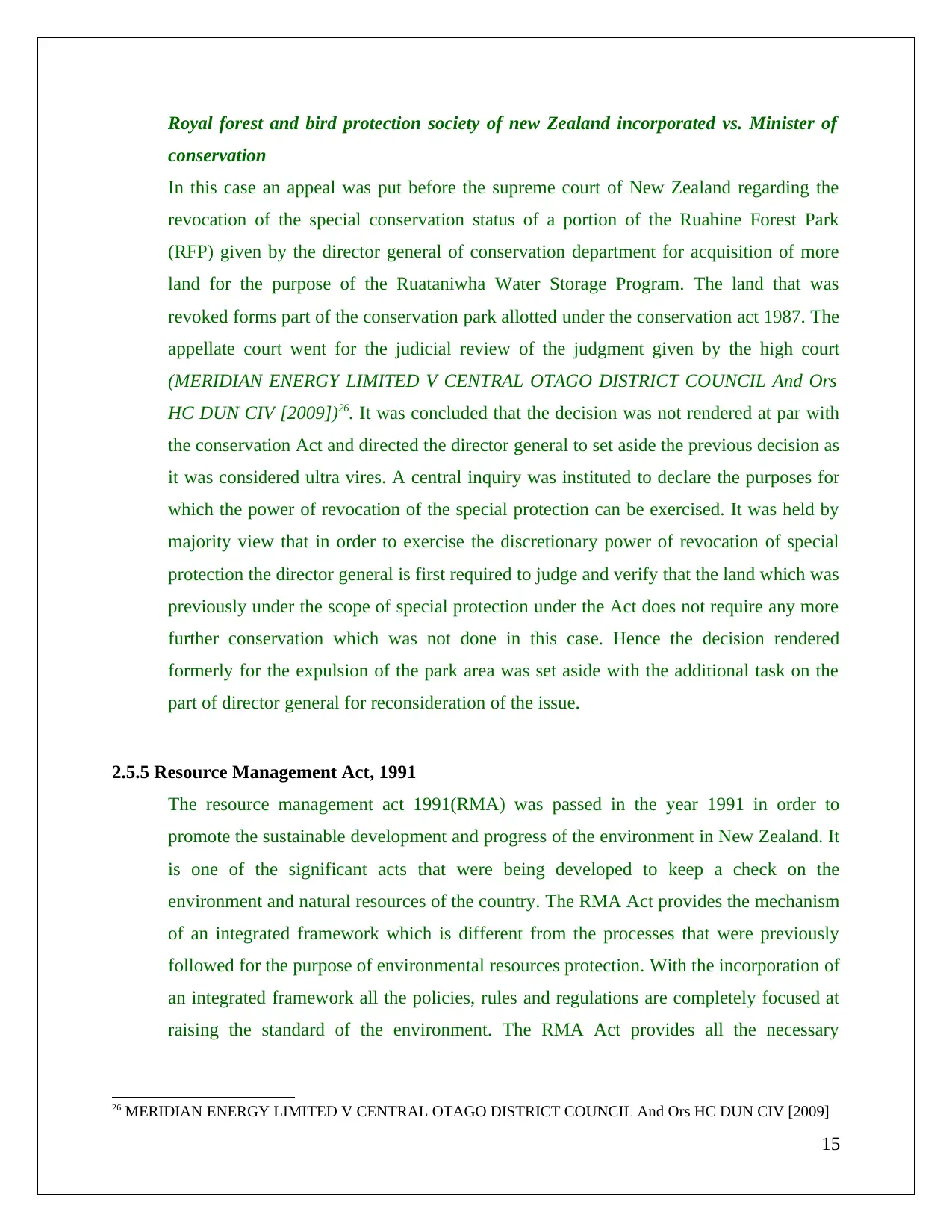
Royal forest and bird protection society of new Zealand incorporated vs. Minister of
conservation
In this case an appeal was put before the supreme court of New Zealand regarding the
revocation of the special conservation status of a portion of the Ruahine Forest Park
(RFP) given by the director general of conservation department for acquisition of more
land for the purpose of the Ruataniwha Water Storage Program. The land that was
revoked forms part of the conservation park allotted under the conservation act 1987. The
appellate court went for the judicial review of the judgment given by the high court
(MERIDIAN ENERGY LIMITED V CENTRAL OTAGO DISTRICT COUNCIL And Ors
HC DUN CIV [2009])26. It was concluded that the decision was not rendered at par with
the conservation Act and directed the director general to set aside the previous decision as
it was considered ultra vires. A central inquiry was instituted to declare the purposes for
which the power of revocation of the special protection can be exercised. It was held by
majority view that in order to exercise the discretionary power of revocation of special
protection the director general is first required to judge and verify that the land which was
previously under the scope of special protection under the Act does not require any more
further conservation which was not done in this case. Hence the decision rendered
formerly for the expulsion of the park area was set aside with the additional task on the
part of director general for reconsideration of the issue.
2.5.5 Resource Management Act, 1991
The resource management act 1991(RMA) was passed in the year 1991 in order to
promote the sustainable development and progress of the environment in New Zealand. It
is one of the significant acts that were being developed to keep a check on the
environment and natural resources of the country. The RMA Act provides the mechanism
of an integrated framework which is different from the processes that were previously
followed for the purpose of environmental resources protection. With the incorporation of
an integrated framework all the policies, rules and regulations are completely focused at
raising the standard of the environment. The RMA Act provides all the necessary
26 MERIDIAN ENERGY LIMITED V CENTRAL OTAGO DISTRICT COUNCIL And Ors HC DUN CIV [2009]
15
conservation
In this case an appeal was put before the supreme court of New Zealand regarding the
revocation of the special conservation status of a portion of the Ruahine Forest Park
(RFP) given by the director general of conservation department for acquisition of more
land for the purpose of the Ruataniwha Water Storage Program. The land that was
revoked forms part of the conservation park allotted under the conservation act 1987. The
appellate court went for the judicial review of the judgment given by the high court
(MERIDIAN ENERGY LIMITED V CENTRAL OTAGO DISTRICT COUNCIL And Ors
HC DUN CIV [2009])26. It was concluded that the decision was not rendered at par with
the conservation Act and directed the director general to set aside the previous decision as
it was considered ultra vires. A central inquiry was instituted to declare the purposes for
which the power of revocation of the special protection can be exercised. It was held by
majority view that in order to exercise the discretionary power of revocation of special
protection the director general is first required to judge and verify that the land which was
previously under the scope of special protection under the Act does not require any more
further conservation which was not done in this case. Hence the decision rendered
formerly for the expulsion of the park area was set aside with the additional task on the
part of director general for reconsideration of the issue.
2.5.5 Resource Management Act, 1991
The resource management act 1991(RMA) was passed in the year 1991 in order to
promote the sustainable development and progress of the environment in New Zealand. It
is one of the significant acts that were being developed to keep a check on the
environment and natural resources of the country. The RMA Act provides the mechanism
of an integrated framework which is different from the processes that were previously
followed for the purpose of environmental resources protection. With the incorporation of
an integrated framework all the policies, rules and regulations are completely focused at
raising the standard of the environment. The RMA Act provides all the necessary
26 MERIDIAN ENERGY LIMITED V CENTRAL OTAGO DISTRICT COUNCIL And Ors HC DUN CIV [2009]
15
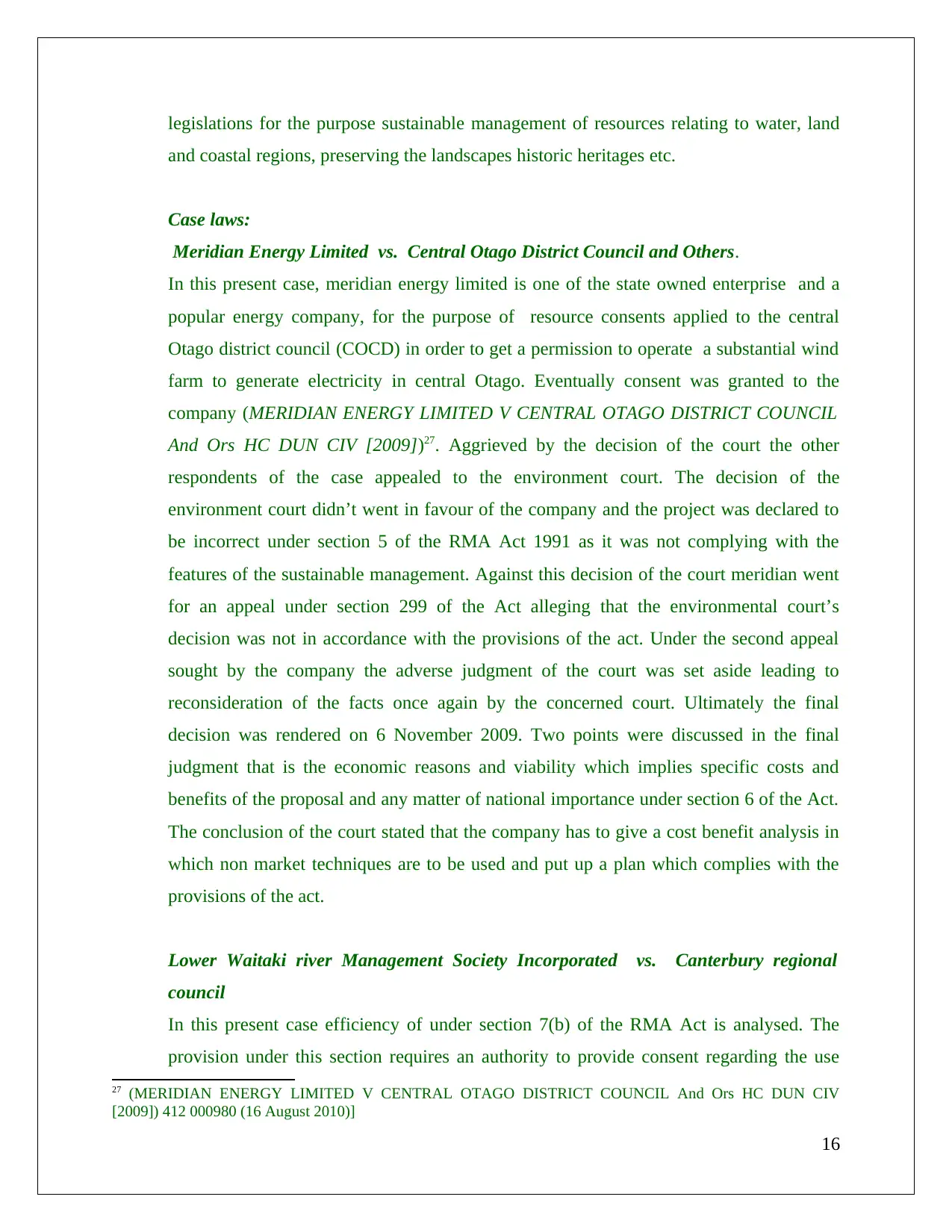
legislations for the purpose sustainable management of resources relating to water, land
and coastal regions, preserving the landscapes historic heritages etc.
Case laws:
Meridian Energy Limited vs. Central Otago District Council and Others.
In this present case, meridian energy limited is one of the state owned enterprise and a
popular energy company, for the purpose of resource consents applied to the central
Otago district council (COCD) in order to get a permission to operate a substantial wind
farm to generate electricity in central Otago. Eventually consent was granted to the
company (MERIDIAN ENERGY LIMITED V CENTRAL OTAGO DISTRICT COUNCIL
And Ors HC DUN CIV [2009])27. Aggrieved by the decision of the court the other
respondents of the case appealed to the environment court. The decision of the
environment court didn’t went in favour of the company and the project was declared to
be incorrect under section 5 of the RMA Act 1991 as it was not complying with the
features of the sustainable management. Against this decision of the court meridian went
for an appeal under section 299 of the Act alleging that the environmental court’s
decision was not in accordance with the provisions of the act. Under the second appeal
sought by the company the adverse judgment of the court was set aside leading to
reconsideration of the facts once again by the concerned court. Ultimately the final
decision was rendered on 6 November 2009. Two points were discussed in the final
judgment that is the economic reasons and viability which implies specific costs and
benefits of the proposal and any matter of national importance under section 6 of the Act.
The conclusion of the court stated that the company has to give a cost benefit analysis in
which non market techniques are to be used and put up a plan which complies with the
provisions of the act.
Lower Waitaki river Management Society Incorporated vs. Canterbury regional
council
In this present case efficiency of under section 7(b) of the RMA Act is analysed. The
provision under this section requires an authority to provide consent regarding the use
27 (MERIDIAN ENERGY LIMITED V CENTRAL OTAGO DISTRICT COUNCIL And Ors HC DUN CIV
[2009]) 412 000980 (16 August 2010)]
16
and coastal regions, preserving the landscapes historic heritages etc.
Case laws:
Meridian Energy Limited vs. Central Otago District Council and Others.
In this present case, meridian energy limited is one of the state owned enterprise and a
popular energy company, for the purpose of resource consents applied to the central
Otago district council (COCD) in order to get a permission to operate a substantial wind
farm to generate electricity in central Otago. Eventually consent was granted to the
company (MERIDIAN ENERGY LIMITED V CENTRAL OTAGO DISTRICT COUNCIL
And Ors HC DUN CIV [2009])27. Aggrieved by the decision of the court the other
respondents of the case appealed to the environment court. The decision of the
environment court didn’t went in favour of the company and the project was declared to
be incorrect under section 5 of the RMA Act 1991 as it was not complying with the
features of the sustainable management. Against this decision of the court meridian went
for an appeal under section 299 of the Act alleging that the environmental court’s
decision was not in accordance with the provisions of the act. Under the second appeal
sought by the company the adverse judgment of the court was set aside leading to
reconsideration of the facts once again by the concerned court. Ultimately the final
decision was rendered on 6 November 2009. Two points were discussed in the final
judgment that is the economic reasons and viability which implies specific costs and
benefits of the proposal and any matter of national importance under section 6 of the Act.
The conclusion of the court stated that the company has to give a cost benefit analysis in
which non market techniques are to be used and put up a plan which complies with the
provisions of the act.
Lower Waitaki river Management Society Incorporated vs. Canterbury regional
council
In this present case efficiency of under section 7(b) of the RMA Act is analysed. The
provision under this section requires an authority to provide consent regarding the use
27 (MERIDIAN ENERGY LIMITED V CENTRAL OTAGO DISTRICT COUNCIL And Ors HC DUN CIV
[2009]) 412 000980 (16 August 2010)]
16
Secure Best Marks with AI Grader
Need help grading? Try our AI Grader for instant feedback on your assignments.
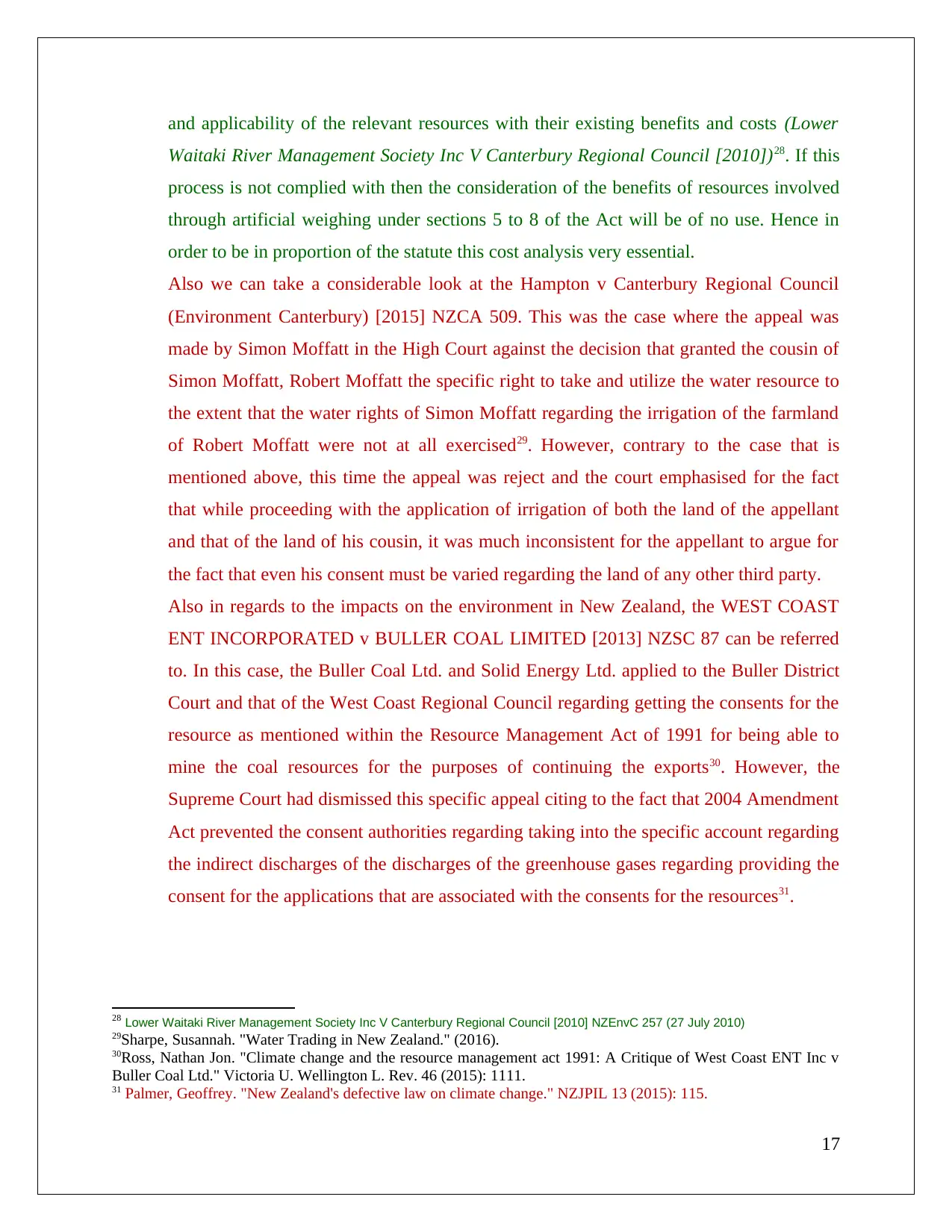
and applicability of the relevant resources with their existing benefits and costs (Lower
Waitaki River Management Society Inc V Canterbury Regional Council [2010])28. If this
process is not complied with then the consideration of the benefits of resources involved
through artificial weighing under sections 5 to 8 of the Act will be of no use. Hence in
order to be in proportion of the statute this cost analysis very essential.
Also we can take a considerable look at the Hampton v Canterbury Regional Council
(Environment Canterbury) [2015] NZCA 509. This was the case where the appeal was
made by Simon Moffatt in the High Court against the decision that granted the cousin of
Simon Moffatt, Robert Moffatt the specific right to take and utilize the water resource to
the extent that the water rights of Simon Moffatt regarding the irrigation of the farmland
of Robert Moffatt were not at all exercised29. However, contrary to the case that is
mentioned above, this time the appeal was reject and the court emphasised for the fact
that while proceeding with the application of irrigation of both the land of the appellant
and that of the land of his cousin, it was much inconsistent for the appellant to argue for
the fact that even his consent must be varied regarding the land of any other third party.
Also in regards to the impacts on the environment in New Zealand, the WEST COAST
ENT INCORPORATED v BULLER COAL LIMITED [2013] NZSC 87 can be referred
to. In this case, the Buller Coal Ltd. and Solid Energy Ltd. applied to the Buller District
Court and that of the West Coast Regional Council regarding getting the consents for the
resource as mentioned within the Resource Management Act of 1991 for being able to
mine the coal resources for the purposes of continuing the exports30. However, the
Supreme Court had dismissed this specific appeal citing to the fact that 2004 Amendment
Act prevented the consent authorities regarding taking into the specific account regarding
the indirect discharges of the discharges of the greenhouse gases regarding providing the
consent for the applications that are associated with the consents for the resources31.
28 Lower Waitaki River Management Society Inc V Canterbury Regional Council [2010] NZEnvC 257 (27 July 2010)
29Sharpe, Susannah. "Water Trading in New Zealand." (2016).
30Ross, Nathan Jon. "Climate change and the resource management act 1991: A Critique of West Coast ENT Inc v
Buller Coal Ltd." Victoria U. Wellington L. Rev. 46 (2015): 1111.
31 Palmer, Geoffrey. "New Zealand's defective law on climate change." NZJPIL 13 (2015): 115.
17
Waitaki River Management Society Inc V Canterbury Regional Council [2010])28. If this
process is not complied with then the consideration of the benefits of resources involved
through artificial weighing under sections 5 to 8 of the Act will be of no use. Hence in
order to be in proportion of the statute this cost analysis very essential.
Also we can take a considerable look at the Hampton v Canterbury Regional Council
(Environment Canterbury) [2015] NZCA 509. This was the case where the appeal was
made by Simon Moffatt in the High Court against the decision that granted the cousin of
Simon Moffatt, Robert Moffatt the specific right to take and utilize the water resource to
the extent that the water rights of Simon Moffatt regarding the irrigation of the farmland
of Robert Moffatt were not at all exercised29. However, contrary to the case that is
mentioned above, this time the appeal was reject and the court emphasised for the fact
that while proceeding with the application of irrigation of both the land of the appellant
and that of the land of his cousin, it was much inconsistent for the appellant to argue for
the fact that even his consent must be varied regarding the land of any other third party.
Also in regards to the impacts on the environment in New Zealand, the WEST COAST
ENT INCORPORATED v BULLER COAL LIMITED [2013] NZSC 87 can be referred
to. In this case, the Buller Coal Ltd. and Solid Energy Ltd. applied to the Buller District
Court and that of the West Coast Regional Council regarding getting the consents for the
resource as mentioned within the Resource Management Act of 1991 for being able to
mine the coal resources for the purposes of continuing the exports30. However, the
Supreme Court had dismissed this specific appeal citing to the fact that 2004 Amendment
Act prevented the consent authorities regarding taking into the specific account regarding
the indirect discharges of the discharges of the greenhouse gases regarding providing the
consent for the applications that are associated with the consents for the resources31.
28 Lower Waitaki River Management Society Inc V Canterbury Regional Council [2010] NZEnvC 257 (27 July 2010)
29Sharpe, Susannah. "Water Trading in New Zealand." (2016).
30Ross, Nathan Jon. "Climate change and the resource management act 1991: A Critique of West Coast ENT Inc v
Buller Coal Ltd." Victoria U. Wellington L. Rev. 46 (2015): 1111.
31 Palmer, Geoffrey. "New Zealand's defective law on climate change." NZJPIL 13 (2015): 115.
17
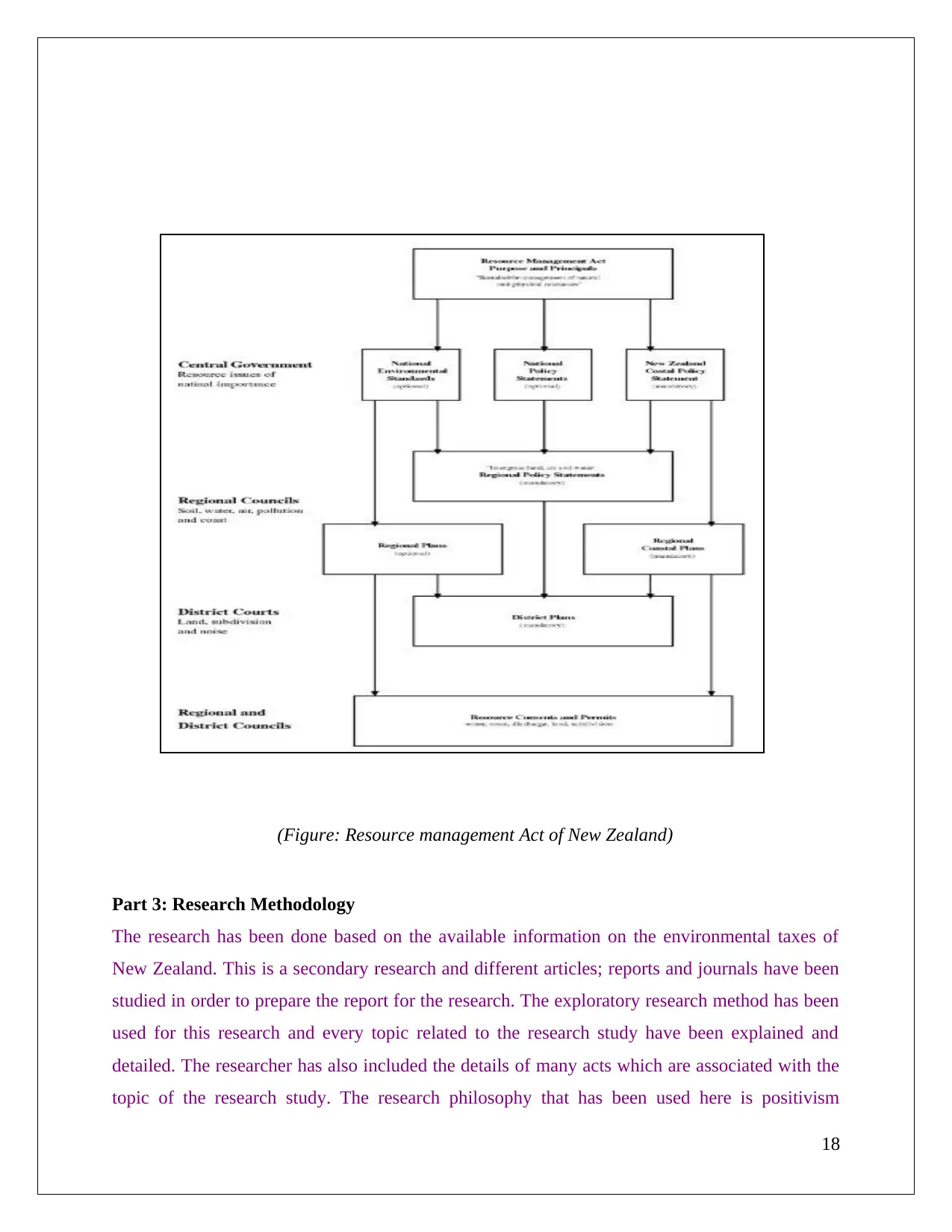
(Figure: Resource management Act of New Zealand)
Part 3: Research Methodology
The research has been done based on the available information on the environmental taxes of
New Zealand. This is a secondary research and different articles; reports and journals have been
studied in order to prepare the report for the research. The exploratory research method has been
used for this research and every topic related to the research study have been explained and
detailed. The researcher has also included the details of many acts which are associated with the
topic of the research study. The research philosophy that has been used here is positivism
18
Part 3: Research Methodology
The research has been done based on the available information on the environmental taxes of
New Zealand. This is a secondary research and different articles; reports and journals have been
studied in order to prepare the report for the research. The exploratory research method has been
used for this research and every topic related to the research study have been explained and
detailed. The researcher has also included the details of many acts which are associated with the
topic of the research study. The research philosophy that has been used here is positivism
18
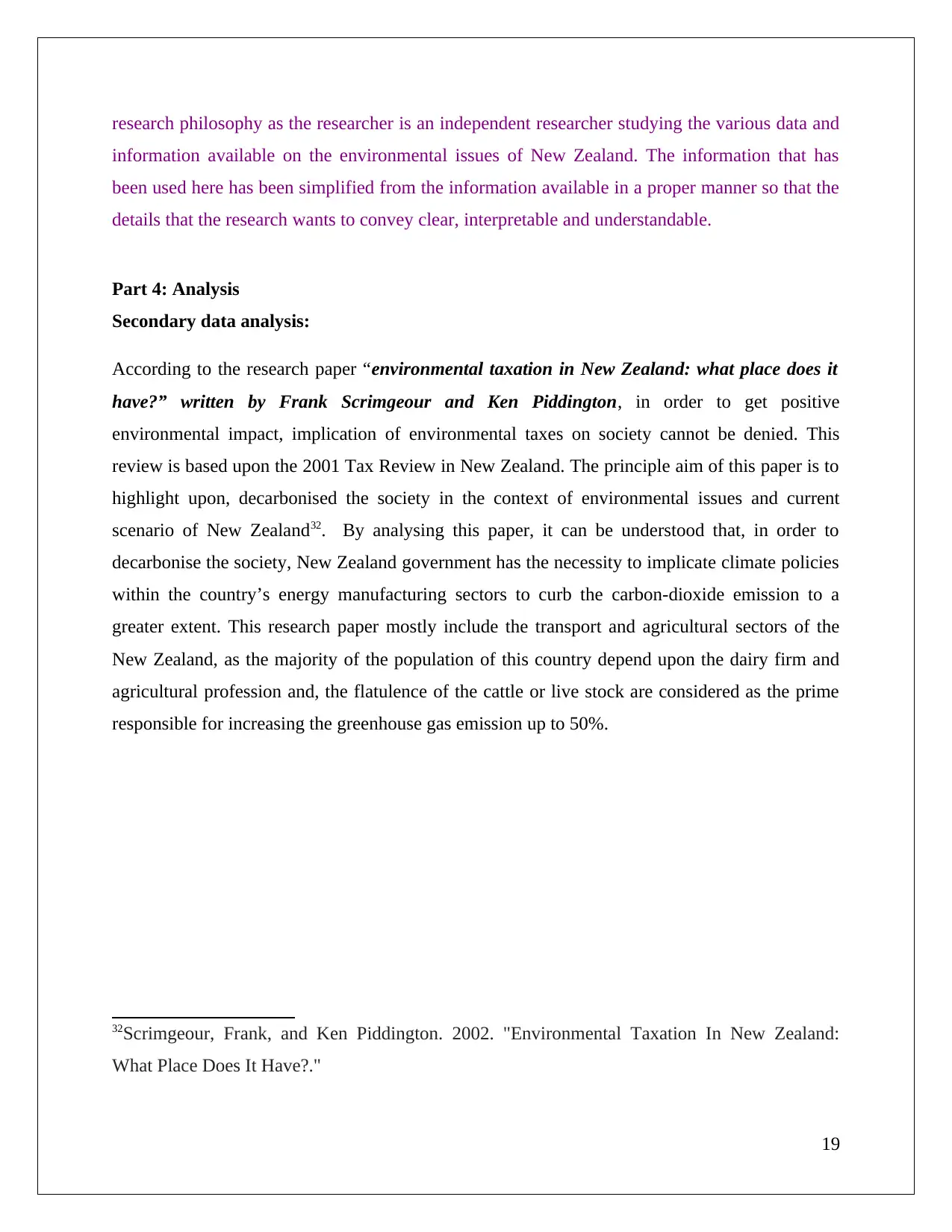
research philosophy as the researcher is an independent researcher studying the various data and
information available on the environmental issues of New Zealand. The information that has
been used here has been simplified from the information available in a proper manner so that the
details that the research wants to convey clear, interpretable and understandable.
Part 4: Analysis
Secondary data analysis:
According to the research paper “environmental taxation in New Zealand: what place does it
have?” written by Frank Scrimgeour and Ken Piddington, in order to get positive
environmental impact, implication of environmental taxes on society cannot be denied. This
review is based upon the 2001 Tax Review in New Zealand. The principle aim of this paper is to
highlight upon, decarbonised the society in the context of environmental issues and current
scenario of New Zealand32. By analysing this paper, it can be understood that, in order to
decarbonise the society, New Zealand government has the necessity to implicate climate policies
within the country’s energy manufacturing sectors to curb the carbon-dioxide emission to a
greater extent. This research paper mostly include the transport and agricultural sectors of the
New Zealand, as the majority of the population of this country depend upon the dairy firm and
agricultural profession and, the flatulence of the cattle or live stock are considered as the prime
responsible for increasing the greenhouse gas emission up to 50%.
32Scrimgeour, Frank, and Ken Piddington. 2002. "Environmental Taxation In New Zealand:
What Place Does It Have?."
19
information available on the environmental issues of New Zealand. The information that has
been used here has been simplified from the information available in a proper manner so that the
details that the research wants to convey clear, interpretable and understandable.
Part 4: Analysis
Secondary data analysis:
According to the research paper “environmental taxation in New Zealand: what place does it
have?” written by Frank Scrimgeour and Ken Piddington, in order to get positive
environmental impact, implication of environmental taxes on society cannot be denied. This
review is based upon the 2001 Tax Review in New Zealand. The principle aim of this paper is to
highlight upon, decarbonised the society in the context of environmental issues and current
scenario of New Zealand32. By analysing this paper, it can be understood that, in order to
decarbonise the society, New Zealand government has the necessity to implicate climate policies
within the country’s energy manufacturing sectors to curb the carbon-dioxide emission to a
greater extent. This research paper mostly include the transport and agricultural sectors of the
New Zealand, as the majority of the population of this country depend upon the dairy firm and
agricultural profession and, the flatulence of the cattle or live stock are considered as the prime
responsible for increasing the greenhouse gas emission up to 50%.
32Scrimgeour, Frank, and Ken Piddington. 2002. "Environmental Taxation In New Zealand:
What Place Does It Have?."
19
Paraphrase This Document
Need a fresh take? Get an instant paraphrase of this document with our AI Paraphraser
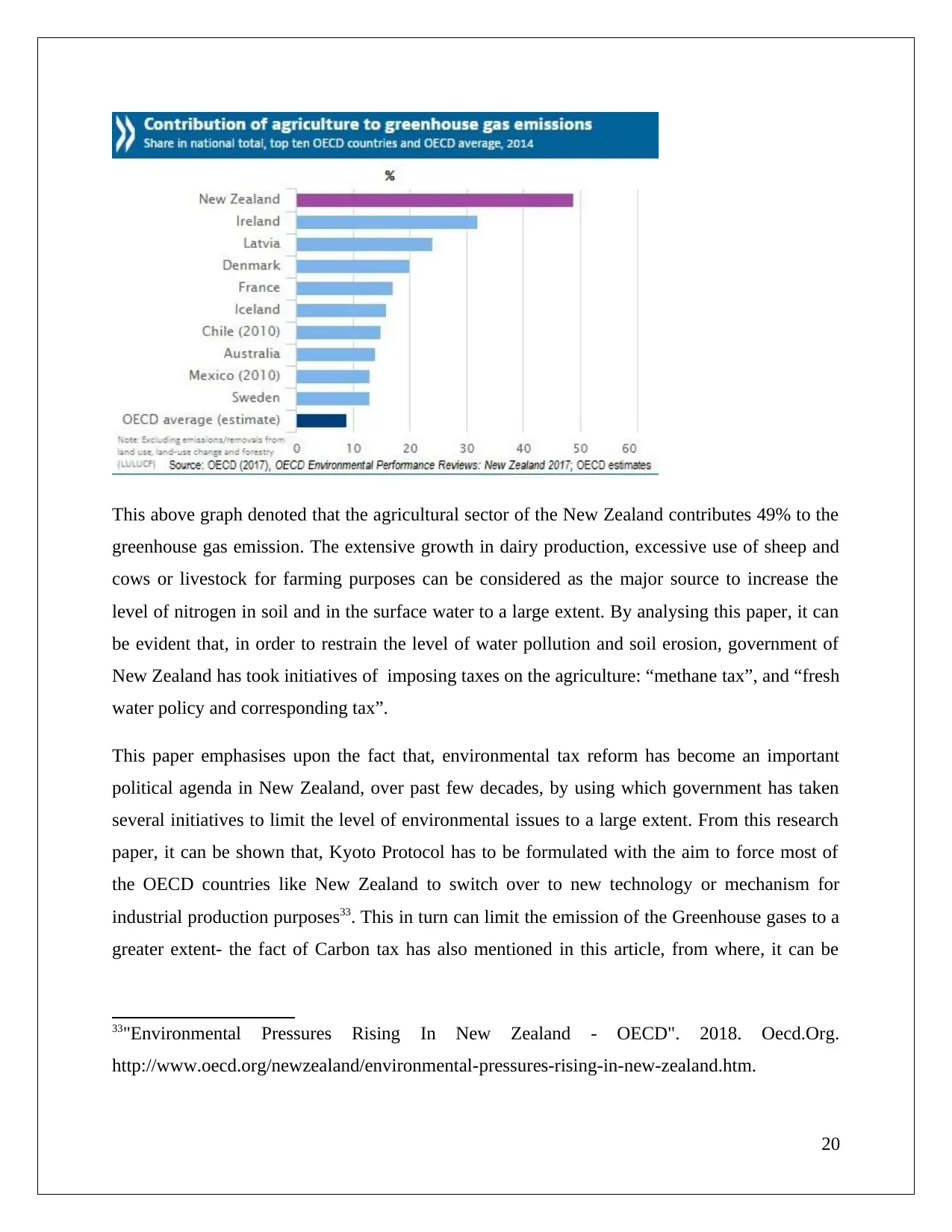
This above graph denoted that the agricultural sector of the New Zealand contributes 49% to the
greenhouse gas emission. The extensive growth in dairy production, excessive use of sheep and
cows or livestock for farming purposes can be considered as the major source to increase the
level of nitrogen in soil and in the surface water to a large extent. By analysing this paper, it can
be evident that, in order to restrain the level of water pollution and soil erosion, government of
New Zealand has took initiatives of imposing taxes on the agriculture: “methane tax”, and “fresh
water policy and corresponding tax”.
This paper emphasises upon the fact that, environmental tax reform has become an important
political agenda in New Zealand, over past few decades, by using which government has taken
several initiatives to limit the level of environmental issues to a large extent. From this research
paper, it can be shown that, Kyoto Protocol has to be formulated with the aim to force most of
the OECD countries like New Zealand to switch over to new technology or mechanism for
industrial production purposes33. This in turn can limit the emission of the Greenhouse gases to a
greater extent- the fact of Carbon tax has also mentioned in this article, from where, it can be
33"Environmental Pressures Rising In New Zealand - OECD". 2018. Oecd.Org.
http://www.oecd.org/newzealand/environmental-pressures-rising-in-new-zealand.htm.
20
greenhouse gas emission. The extensive growth in dairy production, excessive use of sheep and
cows or livestock for farming purposes can be considered as the major source to increase the
level of nitrogen in soil and in the surface water to a large extent. By analysing this paper, it can
be evident that, in order to restrain the level of water pollution and soil erosion, government of
New Zealand has took initiatives of imposing taxes on the agriculture: “methane tax”, and “fresh
water policy and corresponding tax”.
This paper emphasises upon the fact that, environmental tax reform has become an important
political agenda in New Zealand, over past few decades, by using which government has taken
several initiatives to limit the level of environmental issues to a large extent. From this research
paper, it can be shown that, Kyoto Protocol has to be formulated with the aim to force most of
the OECD countries like New Zealand to switch over to new technology or mechanism for
industrial production purposes33. This in turn can limit the emission of the Greenhouse gases to a
greater extent- the fact of Carbon tax has also mentioned in this article, from where, it can be
33"Environmental Pressures Rising In New Zealand - OECD". 2018. Oecd.Org.
http://www.oecd.org/newzealand/environmental-pressures-rising-in-new-zealand.htm.
20
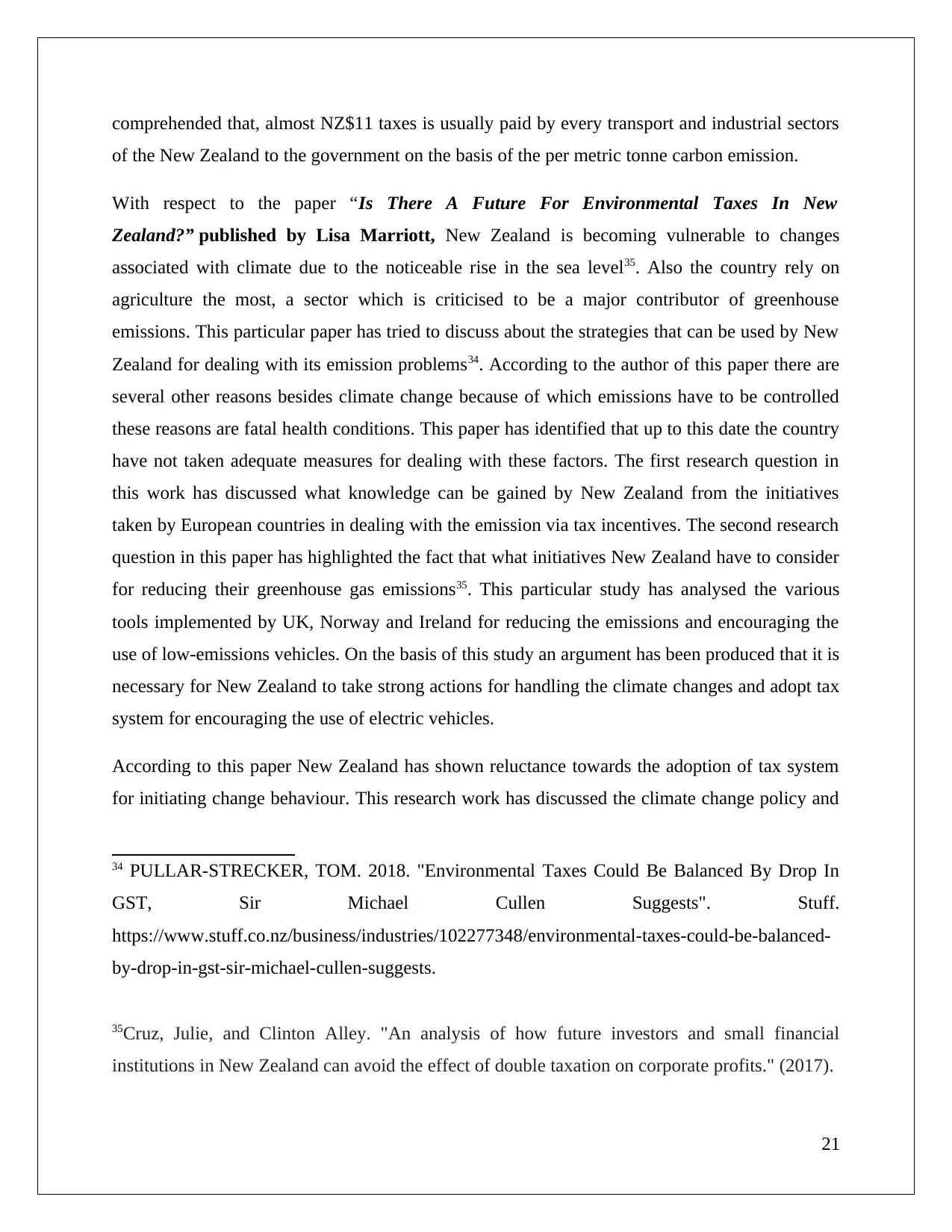
comprehended that, almost NZ$11 taxes is usually paid by every transport and industrial sectors
of the New Zealand to the government on the basis of the per metric tonne carbon emission.
With respect to the paper “Is There A Future For Environmental Taxes In New
Zealand?” published by Lisa Marriott, New Zealand is becoming vulnerable to changes
associated with climate due to the noticeable rise in the sea level35. Also the country rely on
agriculture the most, a sector which is criticised to be a major contributor of greenhouse
emissions. This particular paper has tried to discuss about the strategies that can be used by New
Zealand for dealing with its emission problems34. According to the author of this paper there are
several other reasons besides climate change because of which emissions have to be controlled
these reasons are fatal health conditions. This paper has identified that up to this date the country
have not taken adequate measures for dealing with these factors. The first research question in
this work has discussed what knowledge can be gained by New Zealand from the initiatives
taken by European countries in dealing with the emission via tax incentives. The second research
question in this paper has highlighted the fact that what initiatives New Zealand have to consider
for reducing their greenhouse gas emissions35. This particular study has analysed the various
tools implemented by UK, Norway and Ireland for reducing the emissions and encouraging the
use of low-emissions vehicles. On the basis of this study an argument has been produced that it is
necessary for New Zealand to take strong actions for handling the climate changes and adopt tax
system for encouraging the use of electric vehicles.
According to this paper New Zealand has shown reluctance towards the adoption of tax system
for initiating change behaviour. This research work has discussed the climate change policy and
34 PULLAR-STRECKER, TOM. 2018. "Environmental Taxes Could Be Balanced By Drop In
GST, Sir Michael Cullen Suggests". Stuff.
https://www.stuff.co.nz/business/industries/102277348/environmental-taxes-could-be-balanced-
by-drop-in-gst-sir-michael-cullen-suggests.
35Cruz, Julie, and Clinton Alley. "An analysis of how future investors and small financial
institutions in New Zealand can avoid the effect of double taxation on corporate profits." (2017).
21
of the New Zealand to the government on the basis of the per metric tonne carbon emission.
With respect to the paper “Is There A Future For Environmental Taxes In New
Zealand?” published by Lisa Marriott, New Zealand is becoming vulnerable to changes
associated with climate due to the noticeable rise in the sea level35. Also the country rely on
agriculture the most, a sector which is criticised to be a major contributor of greenhouse
emissions. This particular paper has tried to discuss about the strategies that can be used by New
Zealand for dealing with its emission problems34. According to the author of this paper there are
several other reasons besides climate change because of which emissions have to be controlled
these reasons are fatal health conditions. This paper has identified that up to this date the country
have not taken adequate measures for dealing with these factors. The first research question in
this work has discussed what knowledge can be gained by New Zealand from the initiatives
taken by European countries in dealing with the emission via tax incentives. The second research
question in this paper has highlighted the fact that what initiatives New Zealand have to consider
for reducing their greenhouse gas emissions35. This particular study has analysed the various
tools implemented by UK, Norway and Ireland for reducing the emissions and encouraging the
use of low-emissions vehicles. On the basis of this study an argument has been produced that it is
necessary for New Zealand to take strong actions for handling the climate changes and adopt tax
system for encouraging the use of electric vehicles.
According to this paper New Zealand has shown reluctance towards the adoption of tax system
for initiating change behaviour. This research work has discussed the climate change policy and
34 PULLAR-STRECKER, TOM. 2018. "Environmental Taxes Could Be Balanced By Drop In
GST, Sir Michael Cullen Suggests". Stuff.
https://www.stuff.co.nz/business/industries/102277348/environmental-taxes-could-be-balanced-
by-drop-in-gst-sir-michael-cullen-suggests.
35Cruz, Julie, and Clinton Alley. "An analysis of how future investors and small financial
institutions in New Zealand can avoid the effect of double taxation on corporate profits." (2017).
21
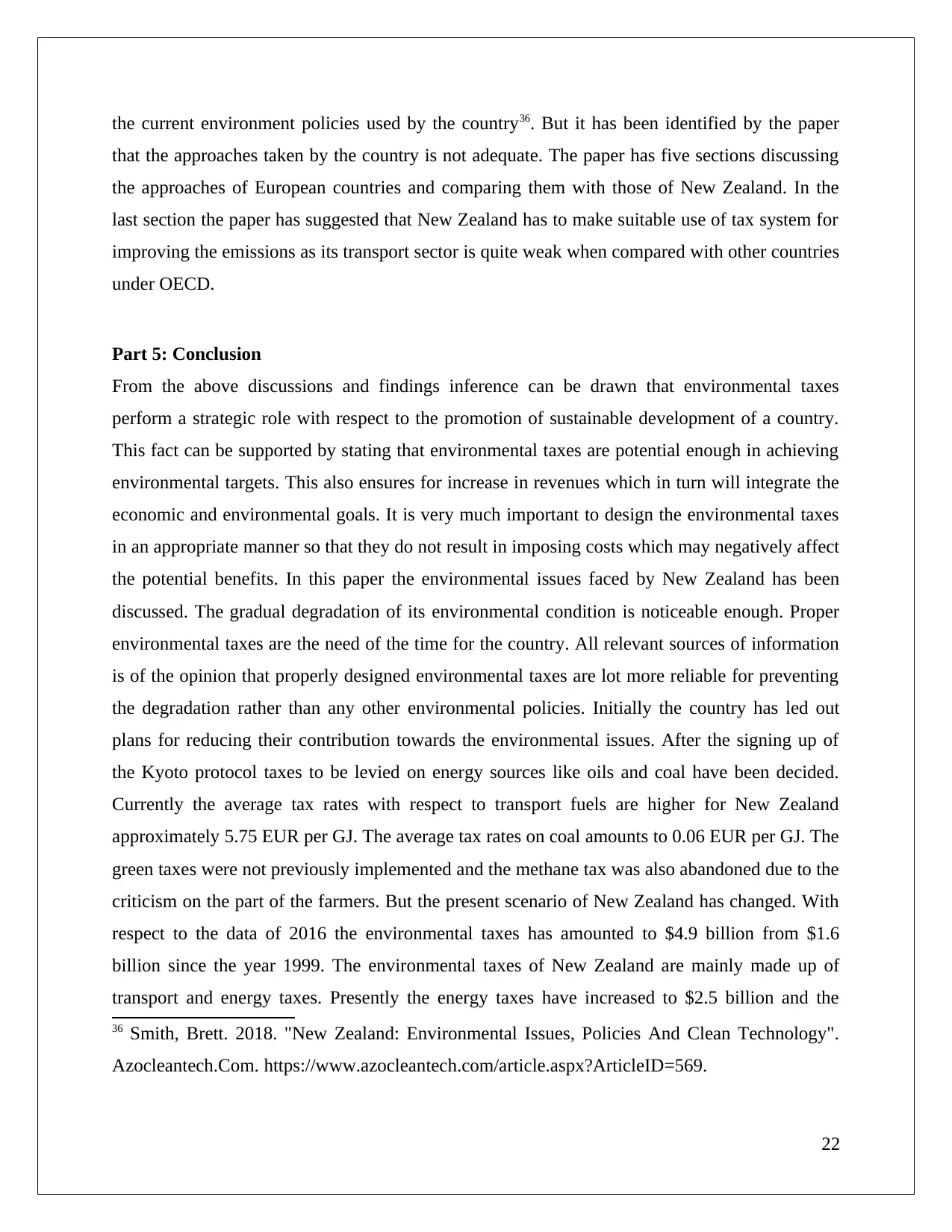
the current environment policies used by the country36. But it has been identified by the paper
that the approaches taken by the country is not adequate. The paper has five sections discussing
the approaches of European countries and comparing them with those of New Zealand. In the
last section the paper has suggested that New Zealand has to make suitable use of tax system for
improving the emissions as its transport sector is quite weak when compared with other countries
under OECD.
Part 5: Conclusion
From the above discussions and findings inference can be drawn that environmental taxes
perform a strategic role with respect to the promotion of sustainable development of a country.
This fact can be supported by stating that environmental taxes are potential enough in achieving
environmental targets. This also ensures for increase in revenues which in turn will integrate the
economic and environmental goals. It is very much important to design the environmental taxes
in an appropriate manner so that they do not result in imposing costs which may negatively affect
the potential benefits. In this paper the environmental issues faced by New Zealand has been
discussed. The gradual degradation of its environmental condition is noticeable enough. Proper
environmental taxes are the need of the time for the country. All relevant sources of information
is of the opinion that properly designed environmental taxes are lot more reliable for preventing
the degradation rather than any other environmental policies. Initially the country has led out
plans for reducing their contribution towards the environmental issues. After the signing up of
the Kyoto protocol taxes to be levied on energy sources like oils and coal have been decided.
Currently the average tax rates with respect to transport fuels are higher for New Zealand
approximately 5.75 EUR per GJ. The average tax rates on coal amounts to 0.06 EUR per GJ. The
green taxes were not previously implemented and the methane tax was also abandoned due to the
criticism on the part of the farmers. But the present scenario of New Zealand has changed. With
respect to the data of 2016 the environmental taxes has amounted to $4.9 billion from $1.6
billion since the year 1999. The environmental taxes of New Zealand are mainly made up of
transport and energy taxes. Presently the energy taxes have increased to $2.5 billion and the
36 Smith, Brett. 2018. "New Zealand: Environmental Issues, Policies And Clean Technology".
Azocleantech.Com. https://www.azocleantech.com/article.aspx?ArticleID=569.
22
that the approaches taken by the country is not adequate. The paper has five sections discussing
the approaches of European countries and comparing them with those of New Zealand. In the
last section the paper has suggested that New Zealand has to make suitable use of tax system for
improving the emissions as its transport sector is quite weak when compared with other countries
under OECD.
Part 5: Conclusion
From the above discussions and findings inference can be drawn that environmental taxes
perform a strategic role with respect to the promotion of sustainable development of a country.
This fact can be supported by stating that environmental taxes are potential enough in achieving
environmental targets. This also ensures for increase in revenues which in turn will integrate the
economic and environmental goals. It is very much important to design the environmental taxes
in an appropriate manner so that they do not result in imposing costs which may negatively affect
the potential benefits. In this paper the environmental issues faced by New Zealand has been
discussed. The gradual degradation of its environmental condition is noticeable enough. Proper
environmental taxes are the need of the time for the country. All relevant sources of information
is of the opinion that properly designed environmental taxes are lot more reliable for preventing
the degradation rather than any other environmental policies. Initially the country has led out
plans for reducing their contribution towards the environmental issues. After the signing up of
the Kyoto protocol taxes to be levied on energy sources like oils and coal have been decided.
Currently the average tax rates with respect to transport fuels are higher for New Zealand
approximately 5.75 EUR per GJ. The average tax rates on coal amounts to 0.06 EUR per GJ. The
green taxes were not previously implemented and the methane tax was also abandoned due to the
criticism on the part of the farmers. But the present scenario of New Zealand has changed. With
respect to the data of 2016 the environmental taxes has amounted to $4.9 billion from $1.6
billion since the year 1999. The environmental taxes of New Zealand are mainly made up of
transport and energy taxes. Presently the energy taxes have increased to $2.5 billion and the
36 Smith, Brett. 2018. "New Zealand: Environmental Issues, Policies And Clean Technology".
Azocleantech.Com. https://www.azocleantech.com/article.aspx?ArticleID=569.
22
Secure Best Marks with AI Grader
Need help grading? Try our AI Grader for instant feedback on your assignments.
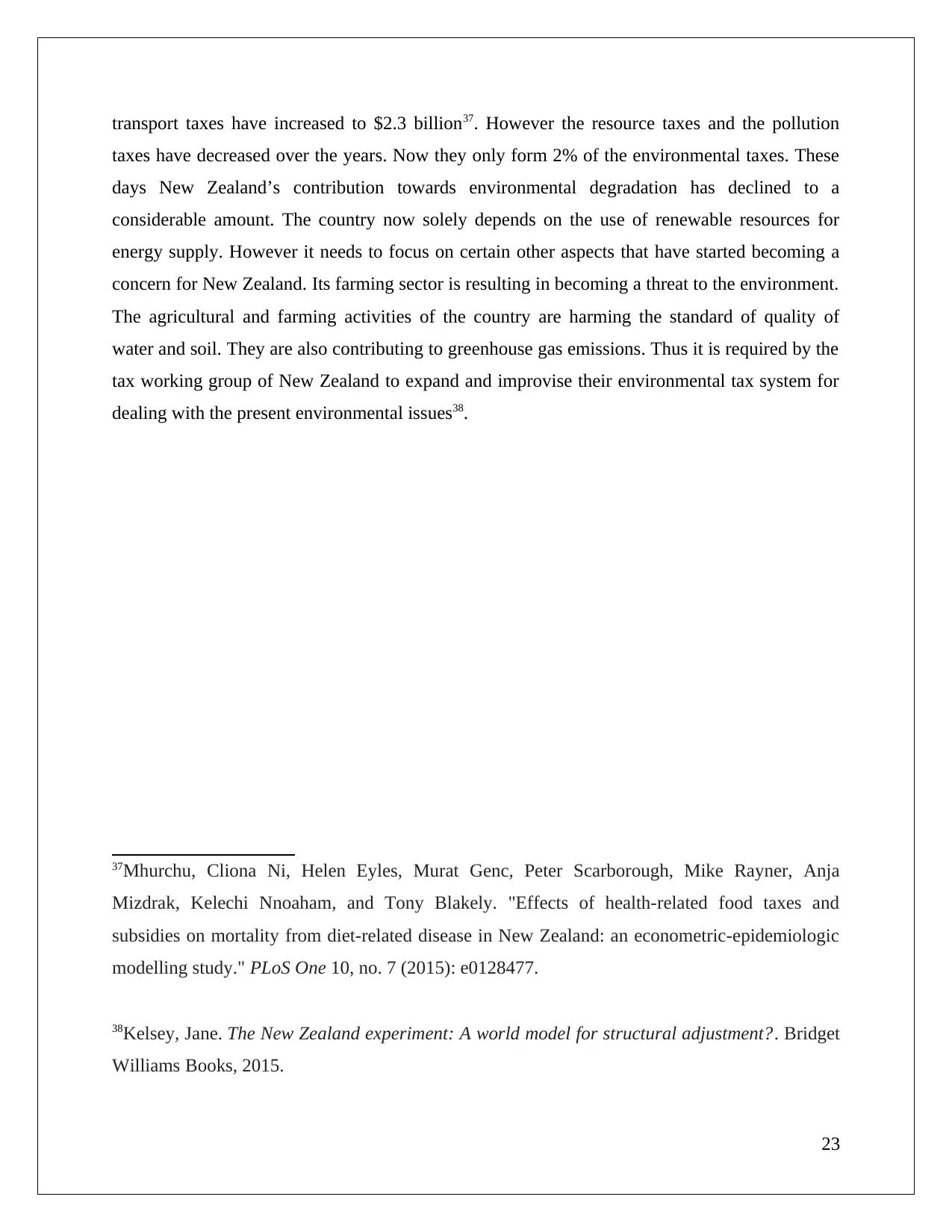
transport taxes have increased to $2.3 billion37. However the resource taxes and the pollution
taxes have decreased over the years. Now they only form 2% of the environmental taxes. These
days New Zealand’s contribution towards environmental degradation has declined to a
considerable amount. The country now solely depends on the use of renewable resources for
energy supply. However it needs to focus on certain other aspects that have started becoming a
concern for New Zealand. Its farming sector is resulting in becoming a threat to the environment.
The agricultural and farming activities of the country are harming the standard of quality of
water and soil. They are also contributing to greenhouse gas emissions. Thus it is required by the
tax working group of New Zealand to expand and improvise their environmental tax system for
dealing with the present environmental issues38.
37Mhurchu, Cliona Ni, Helen Eyles, Murat Genc, Peter Scarborough, Mike Rayner, Anja
Mizdrak, Kelechi Nnoaham, and Tony Blakely. "Effects of health-related food taxes and
subsidies on mortality from diet-related disease in New Zealand: an econometric-epidemiologic
modelling study." PLoS One 10, no. 7 (2015): e0128477.
38Kelsey, Jane. The New Zealand experiment: A world model for structural adjustment?. Bridget
Williams Books, 2015.
23
taxes have decreased over the years. Now they only form 2% of the environmental taxes. These
days New Zealand’s contribution towards environmental degradation has declined to a
considerable amount. The country now solely depends on the use of renewable resources for
energy supply. However it needs to focus on certain other aspects that have started becoming a
concern for New Zealand. Its farming sector is resulting in becoming a threat to the environment.
The agricultural and farming activities of the country are harming the standard of quality of
water and soil. They are also contributing to greenhouse gas emissions. Thus it is required by the
tax working group of New Zealand to expand and improvise their environmental tax system for
dealing with the present environmental issues38.
37Mhurchu, Cliona Ni, Helen Eyles, Murat Genc, Peter Scarborough, Mike Rayner, Anja
Mizdrak, Kelechi Nnoaham, and Tony Blakely. "Effects of health-related food taxes and
subsidies on mortality from diet-related disease in New Zealand: an econometric-epidemiologic
modelling study." PLoS One 10, no. 7 (2015): e0128477.
38Kelsey, Jane. The New Zealand experiment: A world model for structural adjustment?. Bridget
Williams Books, 2015.
23
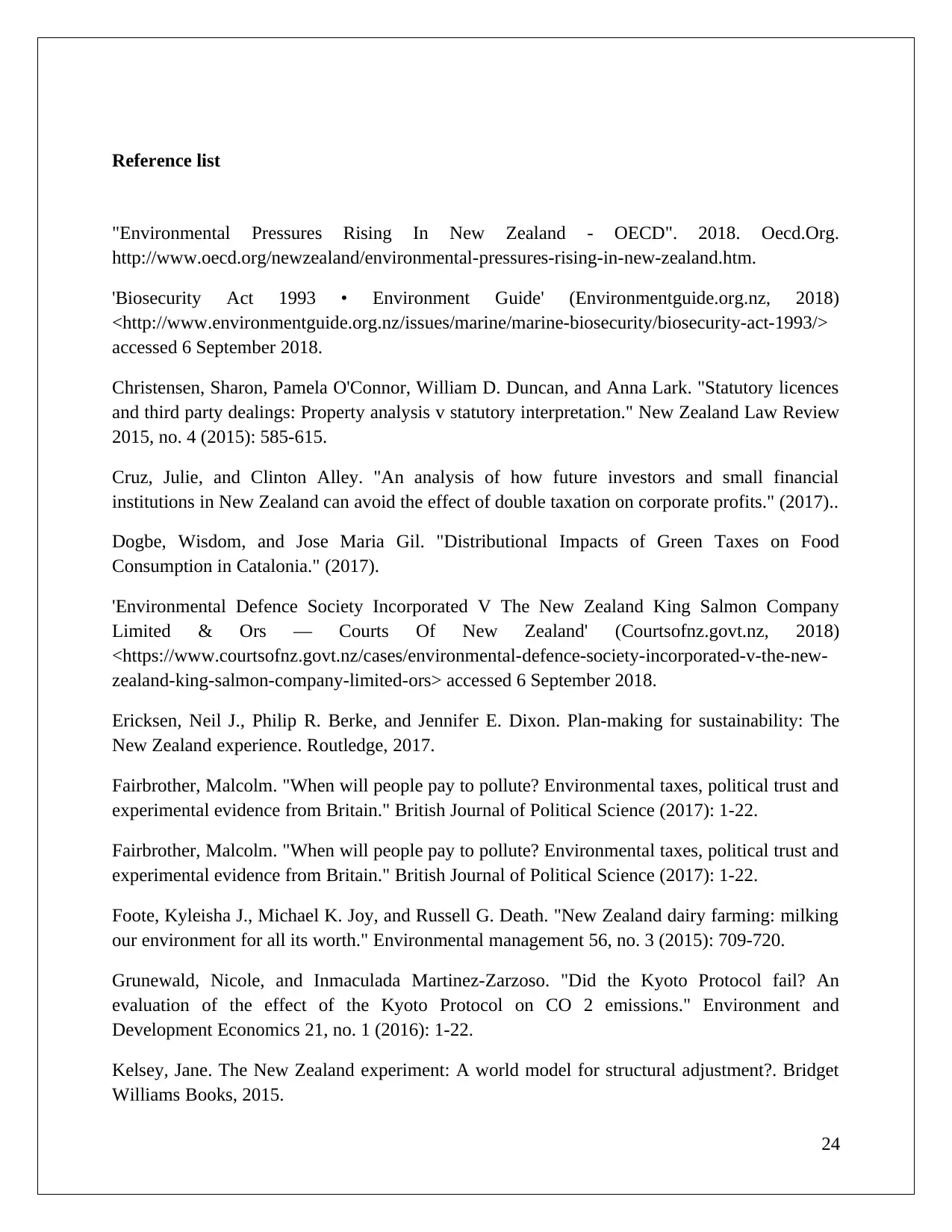
Reference list
"Environmental Pressures Rising In New Zealand - OECD". 2018. Oecd.Org.
http://www.oecd.org/newzealand/environmental-pressures-rising-in-new-zealand.htm.
'Biosecurity Act 1993 • Environment Guide' (Environmentguide.org.nz, 2018)
<http://www.environmentguide.org.nz/issues/marine/marine-biosecurity/biosecurity-act-1993/>
accessed 6 September 2018.
Christensen, Sharon, Pamela O'Connor, William D. Duncan, and Anna Lark. "Statutory licences
and third party dealings: Property analysis v statutory interpretation." New Zealand Law Review
2015, no. 4 (2015): 585-615.
Cruz, Julie, and Clinton Alley. "An analysis of how future investors and small financial
institutions in New Zealand can avoid the effect of double taxation on corporate profits." (2017)..
Dogbe, Wisdom, and Jose Maria Gil. "Distributional Impacts of Green Taxes on Food
Consumption in Catalonia." (2017).
'Environmental Defence Society Incorporated V The New Zealand King Salmon Company
Limited & Ors — Courts Of New Zealand' (Courtsofnz.govt.nz, 2018)
<https://www.courtsofnz.govt.nz/cases/environmental-defence-society-incorporated-v-the-new-
zealand-king-salmon-company-limited-ors> accessed 6 September 2018.
Ericksen, Neil J., Philip R. Berke, and Jennifer E. Dixon. Plan-making for sustainability: The
New Zealand experience. Routledge, 2017.
Fairbrother, Malcolm. "When will people pay to pollute? Environmental taxes, political trust and
experimental evidence from Britain." British Journal of Political Science (2017): 1-22.
Fairbrother, Malcolm. "When will people pay to pollute? Environmental taxes, political trust and
experimental evidence from Britain." British Journal of Political Science (2017): 1-22.
Foote, Kyleisha J., Michael K. Joy, and Russell G. Death. "New Zealand dairy farming: milking
our environment for all its worth." Environmental management 56, no. 3 (2015): 709-720.
Grunewald, Nicole, and Inmaculada Martinez-Zarzoso. "Did the Kyoto Protocol fail? An
evaluation of the effect of the Kyoto Protocol on CO 2 emissions." Environment and
Development Economics 21, no. 1 (2016): 1-22.
Kelsey, Jane. The New Zealand experiment: A world model for structural adjustment?. Bridget
Williams Books, 2015.
24
"Environmental Pressures Rising In New Zealand - OECD". 2018. Oecd.Org.
http://www.oecd.org/newzealand/environmental-pressures-rising-in-new-zealand.htm.
'Biosecurity Act 1993 • Environment Guide' (Environmentguide.org.nz, 2018)
<http://www.environmentguide.org.nz/issues/marine/marine-biosecurity/biosecurity-act-1993/>
accessed 6 September 2018.
Christensen, Sharon, Pamela O'Connor, William D. Duncan, and Anna Lark. "Statutory licences
and third party dealings: Property analysis v statutory interpretation." New Zealand Law Review
2015, no. 4 (2015): 585-615.
Cruz, Julie, and Clinton Alley. "An analysis of how future investors and small financial
institutions in New Zealand can avoid the effect of double taxation on corporate profits." (2017)..
Dogbe, Wisdom, and Jose Maria Gil. "Distributional Impacts of Green Taxes on Food
Consumption in Catalonia." (2017).
'Environmental Defence Society Incorporated V The New Zealand King Salmon Company
Limited & Ors — Courts Of New Zealand' (Courtsofnz.govt.nz, 2018)
<https://www.courtsofnz.govt.nz/cases/environmental-defence-society-incorporated-v-the-new-
zealand-king-salmon-company-limited-ors> accessed 6 September 2018.
Ericksen, Neil J., Philip R. Berke, and Jennifer E. Dixon. Plan-making for sustainability: The
New Zealand experience. Routledge, 2017.
Fairbrother, Malcolm. "When will people pay to pollute? Environmental taxes, political trust and
experimental evidence from Britain." British Journal of Political Science (2017): 1-22.
Fairbrother, Malcolm. "When will people pay to pollute? Environmental taxes, political trust and
experimental evidence from Britain." British Journal of Political Science (2017): 1-22.
Foote, Kyleisha J., Michael K. Joy, and Russell G. Death. "New Zealand dairy farming: milking
our environment for all its worth." Environmental management 56, no. 3 (2015): 709-720.
Grunewald, Nicole, and Inmaculada Martinez-Zarzoso. "Did the Kyoto Protocol fail? An
evaluation of the effect of the Kyoto Protocol on CO 2 emissions." Environment and
Development Economics 21, no. 1 (2016): 1-22.
Kelsey, Jane. The New Zealand experiment: A world model for structural adjustment?. Bridget
Williams Books, 2015.
24
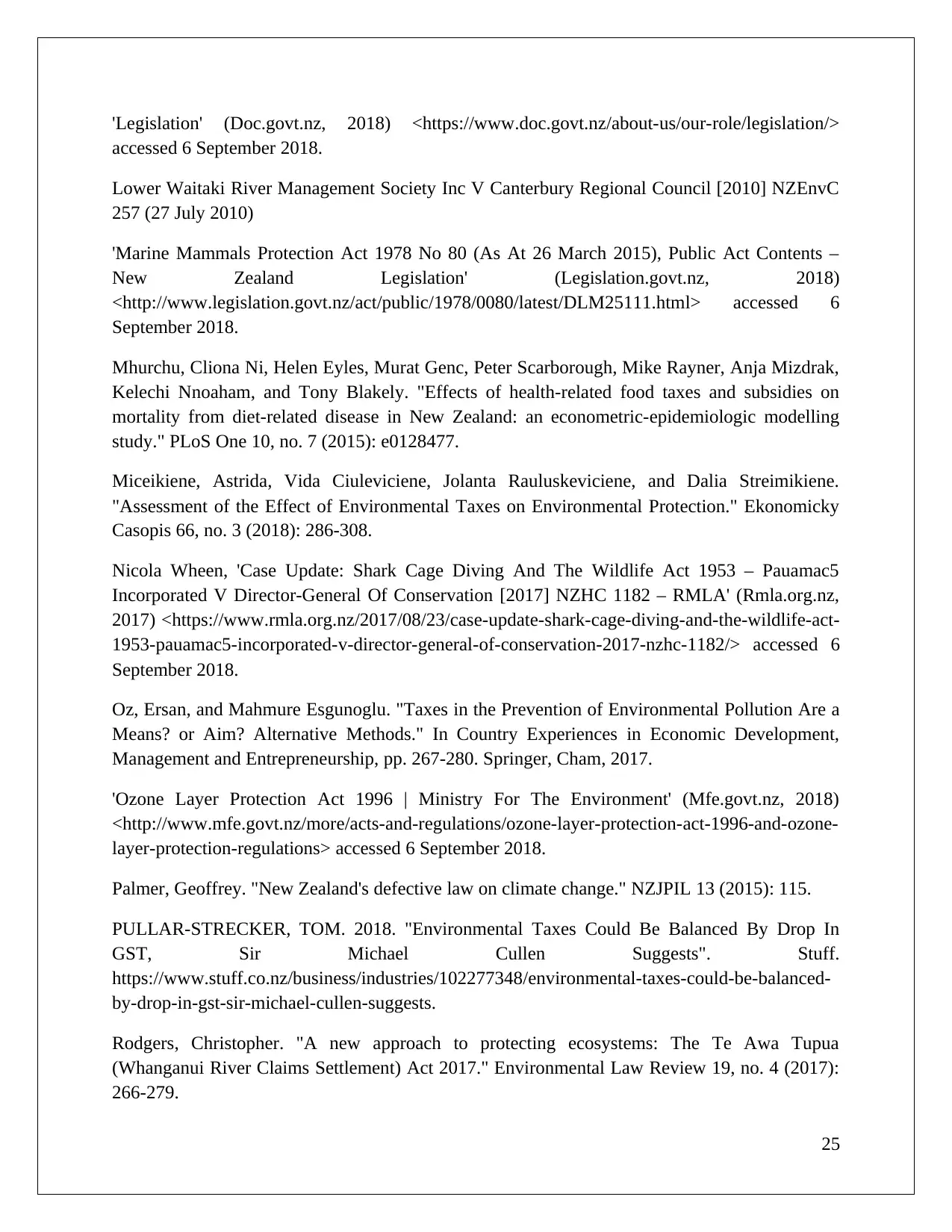
'Legislation' (Doc.govt.nz, 2018) <https://www.doc.govt.nz/about-us/our-role/legislation/>
accessed 6 September 2018.
Lower Waitaki River Management Society Inc V Canterbury Regional Council [2010] NZEnvC
257 (27 July 2010)
'Marine Mammals Protection Act 1978 No 80 (As At 26 March 2015), Public Act Contents –
New Zealand Legislation' (Legislation.govt.nz, 2018)
<http://www.legislation.govt.nz/act/public/1978/0080/latest/DLM25111.html> accessed 6
September 2018.
Mhurchu, Cliona Ni, Helen Eyles, Murat Genc, Peter Scarborough, Mike Rayner, Anja Mizdrak,
Kelechi Nnoaham, and Tony Blakely. "Effects of health-related food taxes and subsidies on
mortality from diet-related disease in New Zealand: an econometric-epidemiologic modelling
study." PLoS One 10, no. 7 (2015): e0128477.
Miceikiene, Astrida, Vida Ciuleviciene, Jolanta Rauluskeviciene, and Dalia Streimikiene.
"Assessment of the Effect of Environmental Taxes on Environmental Protection." Ekonomicky
Casopis 66, no. 3 (2018): 286-308.
Nicola Wheen, 'Case Update: Shark Cage Diving And The Wildlife Act 1953 – Pauamac5
Incorporated V Director-General Of Conservation [2017] NZHC 1182 – RMLA' (Rmla.org.nz,
2017) <https://www.rmla.org.nz/2017/08/23/case-update-shark-cage-diving-and-the-wildlife-act-
1953-pauamac5-incorporated-v-director-general-of-conservation-2017-nzhc-1182/> accessed 6
September 2018.
Oz, Ersan, and Mahmure Esgunoglu. "Taxes in the Prevention of Environmental Pollution Are a
Means? or Aim? Alternative Methods." In Country Experiences in Economic Development,
Management and Entrepreneurship, pp. 267-280. Springer, Cham, 2017.
'Ozone Layer Protection Act 1996 | Ministry For The Environment' (Mfe.govt.nz, 2018)
<http://www.mfe.govt.nz/more/acts-and-regulations/ozone-layer-protection-act-1996-and-ozone-
layer-protection-regulations> accessed 6 September 2018.
Palmer, Geoffrey. "New Zealand's defective law on climate change." NZJPIL 13 (2015): 115.
PULLAR-STRECKER, TOM. 2018. "Environmental Taxes Could Be Balanced By Drop In
GST, Sir Michael Cullen Suggests". Stuff.
https://www.stuff.co.nz/business/industries/102277348/environmental-taxes-could-be-balanced-
by-drop-in-gst-sir-michael-cullen-suggests.
Rodgers, Christopher. "A new approach to protecting ecosystems: The Te Awa Tupua
(Whanganui River Claims Settlement) Act 2017." Environmental Law Review 19, no. 4 (2017):
266-279.
25
accessed 6 September 2018.
Lower Waitaki River Management Society Inc V Canterbury Regional Council [2010] NZEnvC
257 (27 July 2010)
'Marine Mammals Protection Act 1978 No 80 (As At 26 March 2015), Public Act Contents –
New Zealand Legislation' (Legislation.govt.nz, 2018)
<http://www.legislation.govt.nz/act/public/1978/0080/latest/DLM25111.html> accessed 6
September 2018.
Mhurchu, Cliona Ni, Helen Eyles, Murat Genc, Peter Scarborough, Mike Rayner, Anja Mizdrak,
Kelechi Nnoaham, and Tony Blakely. "Effects of health-related food taxes and subsidies on
mortality from diet-related disease in New Zealand: an econometric-epidemiologic modelling
study." PLoS One 10, no. 7 (2015): e0128477.
Miceikiene, Astrida, Vida Ciuleviciene, Jolanta Rauluskeviciene, and Dalia Streimikiene.
"Assessment of the Effect of Environmental Taxes on Environmental Protection." Ekonomicky
Casopis 66, no. 3 (2018): 286-308.
Nicola Wheen, 'Case Update: Shark Cage Diving And The Wildlife Act 1953 – Pauamac5
Incorporated V Director-General Of Conservation [2017] NZHC 1182 – RMLA' (Rmla.org.nz,
2017) <https://www.rmla.org.nz/2017/08/23/case-update-shark-cage-diving-and-the-wildlife-act-
1953-pauamac5-incorporated-v-director-general-of-conservation-2017-nzhc-1182/> accessed 6
September 2018.
Oz, Ersan, and Mahmure Esgunoglu. "Taxes in the Prevention of Environmental Pollution Are a
Means? or Aim? Alternative Methods." In Country Experiences in Economic Development,
Management and Entrepreneurship, pp. 267-280. Springer, Cham, 2017.
'Ozone Layer Protection Act 1996 | Ministry For The Environment' (Mfe.govt.nz, 2018)
<http://www.mfe.govt.nz/more/acts-and-regulations/ozone-layer-protection-act-1996-and-ozone-
layer-protection-regulations> accessed 6 September 2018.
Palmer, Geoffrey. "New Zealand's defective law on climate change." NZJPIL 13 (2015): 115.
PULLAR-STRECKER, TOM. 2018. "Environmental Taxes Could Be Balanced By Drop In
GST, Sir Michael Cullen Suggests". Stuff.
https://www.stuff.co.nz/business/industries/102277348/environmental-taxes-could-be-balanced-
by-drop-in-gst-sir-michael-cullen-suggests.
Rodgers, Christopher. "A new approach to protecting ecosystems: The Te Awa Tupua
(Whanganui River Claims Settlement) Act 2017." Environmental Law Review 19, no. 4 (2017):
266-279.
25
Paraphrase This Document
Need a fresh take? Get an instant paraphrase of this document with our AI Paraphraser
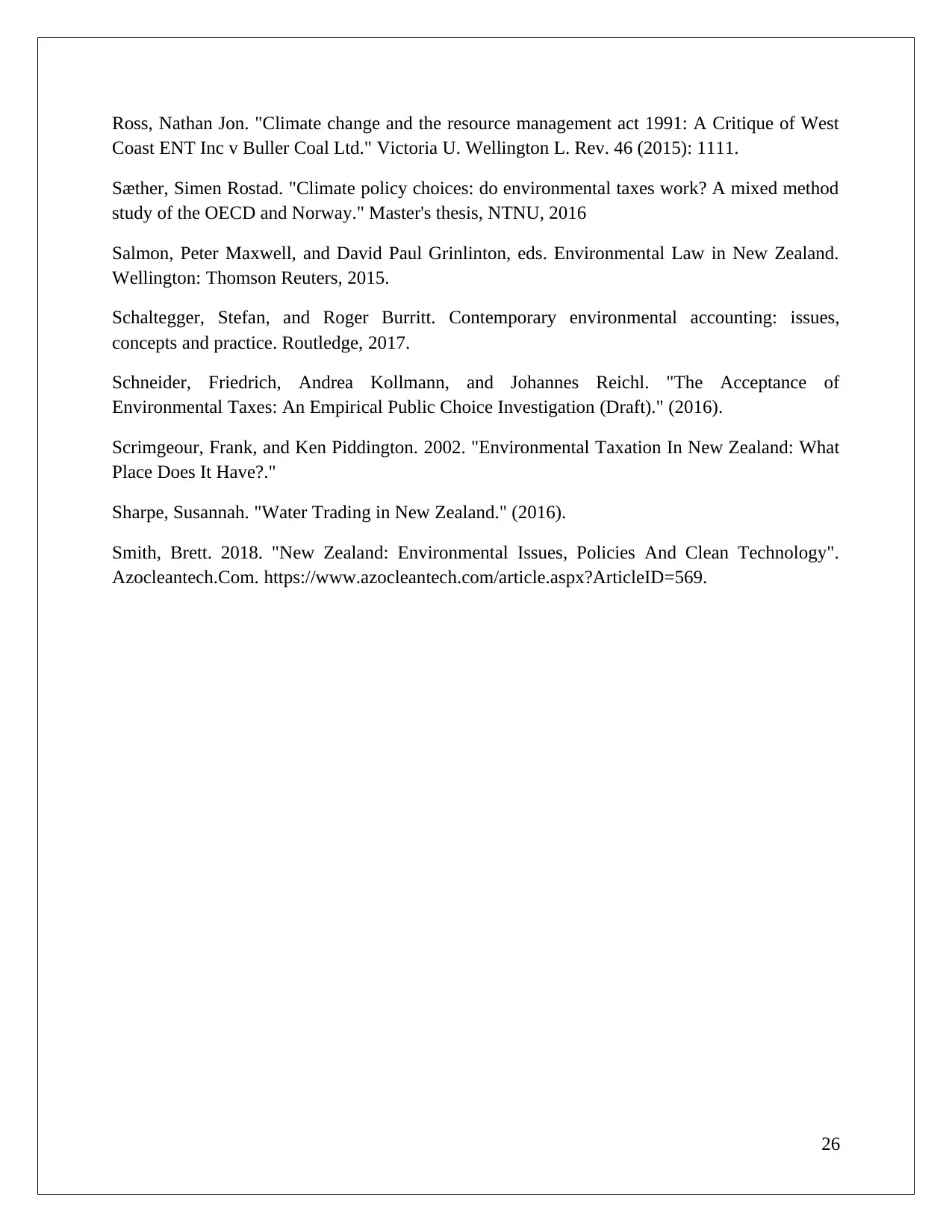
Ross, Nathan Jon. "Climate change and the resource management act 1991: A Critique of West
Coast ENT Inc v Buller Coal Ltd." Victoria U. Wellington L. Rev. 46 (2015): 1111.
Sæther, Simen Rostad. "Climate policy choices: do environmental taxes work? A mixed method
study of the OECD and Norway." Master's thesis, NTNU, 2016
Salmon, Peter Maxwell, and David Paul Grinlinton, eds. Environmental Law in New Zealand.
Wellington: Thomson Reuters, 2015.
Schaltegger, Stefan, and Roger Burritt. Contemporary environmental accounting: issues,
concepts and practice. Routledge, 2017.
Schneider, Friedrich, Andrea Kollmann, and Johannes Reichl. "The Acceptance of
Environmental Taxes: An Empirical Public Choice Investigation (Draft)." (2016).
Scrimgeour, Frank, and Ken Piddington. 2002. "Environmental Taxation In New Zealand: What
Place Does It Have?."
Sharpe, Susannah. "Water Trading in New Zealand." (2016).
Smith, Brett. 2018. "New Zealand: Environmental Issues, Policies And Clean Technology".
Azocleantech.Com. https://www.azocleantech.com/article.aspx?ArticleID=569.
26
Coast ENT Inc v Buller Coal Ltd." Victoria U. Wellington L. Rev. 46 (2015): 1111.
Sæther, Simen Rostad. "Climate policy choices: do environmental taxes work? A mixed method
study of the OECD and Norway." Master's thesis, NTNU, 2016
Salmon, Peter Maxwell, and David Paul Grinlinton, eds. Environmental Law in New Zealand.
Wellington: Thomson Reuters, 2015.
Schaltegger, Stefan, and Roger Burritt. Contemporary environmental accounting: issues,
concepts and practice. Routledge, 2017.
Schneider, Friedrich, Andrea Kollmann, and Johannes Reichl. "The Acceptance of
Environmental Taxes: An Empirical Public Choice Investigation (Draft)." (2016).
Scrimgeour, Frank, and Ken Piddington. 2002. "Environmental Taxation In New Zealand: What
Place Does It Have?."
Sharpe, Susannah. "Water Trading in New Zealand." (2016).
Smith, Brett. 2018. "New Zealand: Environmental Issues, Policies And Clean Technology".
Azocleantech.Com. https://www.azocleantech.com/article.aspx?ArticleID=569.
26
1 out of 26
Your All-in-One AI-Powered Toolkit for Academic Success.
+13062052269
info@desklib.com
Available 24*7 on WhatsApp / Email
![[object Object]](/_next/static/media/star-bottom.7253800d.svg)
Unlock your academic potential
© 2024 | Zucol Services PVT LTD | All rights reserved.